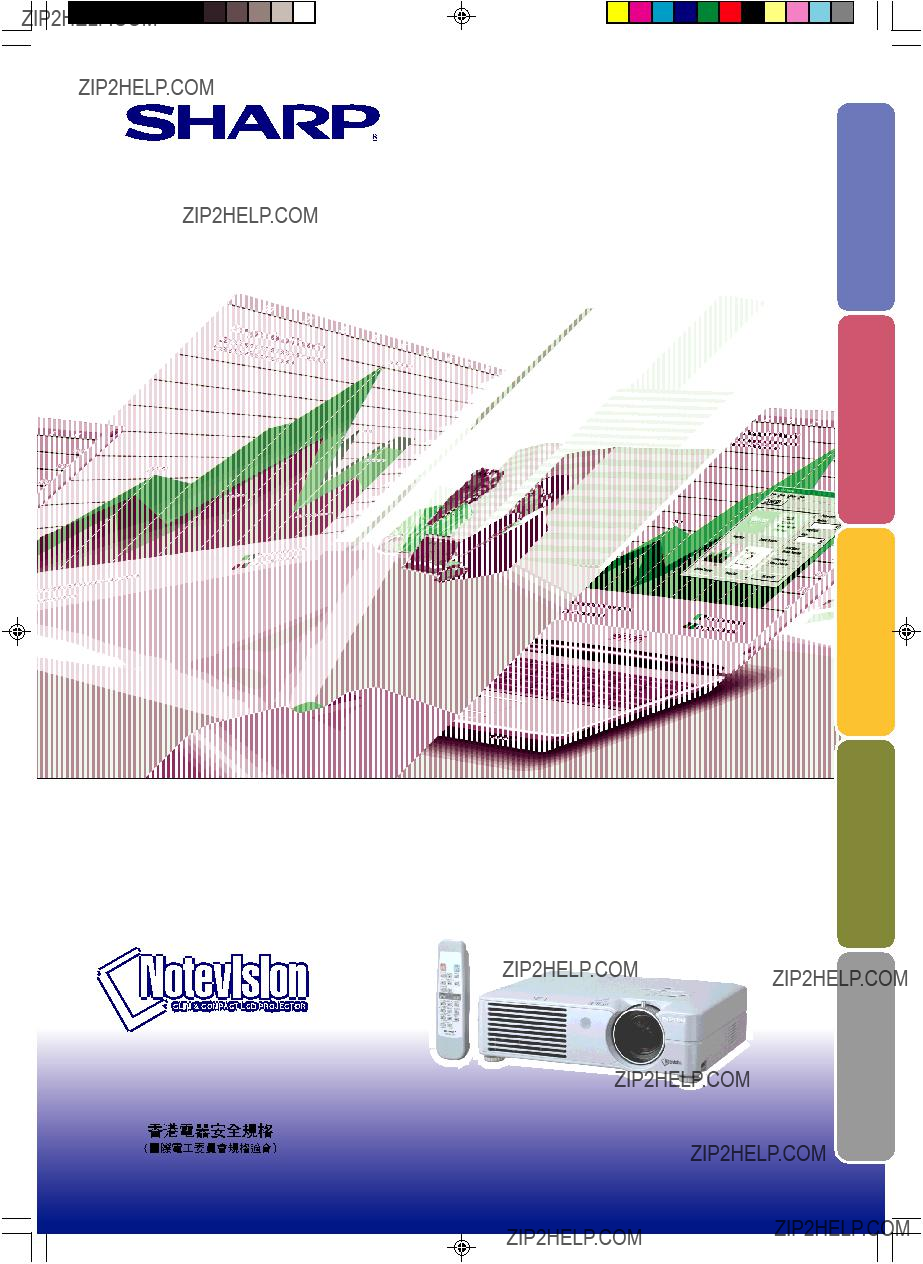
LCD PROJECTOR
OPERATION MANUAL
MODEL
Introduction
and Connections
Setup
Operation Basic
to Easy
Functions Use
Appendix

LCD PROJECTOR
OPERATION MANUAL
MODEL
Introduction
and Connections
Setup
Operation Basic
to Easy
Functions Use
Appendix

IMPORTANT
For your assistance in reporting the loss or theft of your Projector, please record the Serial Number located on the bottom of the projector and retain this information. Before recycling the packaging, please be sure that you have checked the contents of the carton thoroughly against the list of ???Supplied accessories??? on page 14.
Model No.:
Serial No.:
This equipment complies with the requirements of Directives 89/336/EEC and 73/23/EEC as amended by 93/68/ EEC.
Dieses Ger??t entspricht den Anforderungen der
Ce mat??riel r??pond aux exigences contenues dans les directives 89/336/CEE et 73/23/CEE modifi??es par la directive 93/68/CEE.
Dit apparaat voldoet aan de eisen van de richtlijnen 89/336/EEG en 73/23/EEG, gewijzigd door 93/68/EEG. Dette udstyr overholder kravene i direktiv nr. 89/336/EEC og 73/23/EEC med till??g nr. 93/68/EEC.
Quest??? apparecchio ?? conforme ai requisiti delle direttive 89/336/EEC e 73/23/EEC, come emendata dalla direttiva 93/68/EEC.
Este equipamento obedece ??s exig??ncias das directivas 89/336/CEE e 73/23/CEE, na sua vers??o corrigida pela directiva 93/68/CEE.
Este aparato satisface las exigencias de las Directivas 89/336/CEE y 73/23/CEE, modificadas por medio de la 93/68/CEE.
Denna utrustning uppfyller kraven enligt riktlinjerna 89/336/EEC och 73/23/EEC s?? som kompletteras av 93/68/ EEC.
Dette produktet oppfyller betingelsene i direktivene 89/336/EEC og 73/23/EEC i endringen 93/68/EEC.
T??m?? laite t??ytt???? direktiivien 89/336/EEC ja 73/23/EEC vaatimukset, joita on muutettu direktiivill?? 93/68/EEC.

SPECIAL NOTE FOR USERS IN THE U.K.
The mains lead of this product is fitted with a  or
or  and of the same rating as above, which is also indicated on the pin face of the plug, must be used.
and of the same rating as above, which is also indicated on the pin face of the plug, must be used.
Always refit the fuse cover after replacing the fuse. Never use the plug without the fuse cover fitted.
In the unlikely event of the socket outlet in your home not being compatible with the plug supplied, cut off the mains plug and fit an appropriate type.
DANGER:
The fuse from the
Under no circumstances should the
To fit an appropriate plug to the mains lead, follow the instructions below:
IMPORTANT:
The wires in the mains lead are coloured in accordance with the following code: Blue: Neutral
Brown: Live
As the colours of the wires in the mains lead of this product may not correspond with the coloured markings identifying the terminals in your plug, proceed as follows:
???The wire which is coloured blue must be connected to the plug terminal which is marked N or coloured black.
???The wire which is coloured brown must be connected to the plug terminal which is marked L or coloured red. Ensure that neither the brown nor the blue wire is connected to the earth terminal in your
Before replacing the plug cover make sure that:
???If the new fitted plug contains a fuse, its value is the same as that removed from the
???The cord grip is clamped over the sheath of the mains lead, and not simply over the lead wires.
IF YOU HAVE ANY DOUBT, CONSULT A QUALIFIED ELECTRICIAN.

The supplied
Die mitgelieferte
Le
Den medf??ljande
El
Il
De meegeleverde
O

Before using the projector, please read this operation manual carefully.
There are two important reasons for prompt warranty registration of your new SHARP Projector, using the REGISTRATION CARD packed with the projector.
1.WARRANTY
This is to assure that you immediately receive the full benefit of the parts, service and labor warranty applicable to your purchase.
2.CONSUMER PRODUCT SAFETY ACT
To ensure that you will promptly receive any safety notification of inspection, modification, or recall that SHARP may be required to give under the 1972 Consumer Product Safety Act, PLEASE
READ CAREFULLY THE IMPORTANT ???LIMITED WARRANTY??? CLAUSE.
WARNING: High brightness light source. Do not stare into the beam of light, or view directly. Be especially careful that children do not stare directly into the beam of light.
WARNING: To reduce the risk of fire or electric shock, do not expose this product to rain or moisture.
See bottom of projector.
Introduction
The lightning flash with arrowhead symbol, within an equilateral triangle, is intended to alert the user to the presence of uninsulated ???dangerous voltage??? within the product???s enclosure that may be of sufficient magnitude to constitute a risk or electric shock to persons.
The exclamation point within a triangle is intended to alert the user to the presence of important operating and maintenance (servicing) instructions in the literature accompanying the product.
WARNING: FCC Regulations state that any unauthorized changes or modifications to this equipment not expressly approved by the manufacturer could void the user???s authority to operate this equip- ment. 

INFORMATION
This equipment has been tested and found to comply with the limits for a Class A digital device, pursuant to Part 15 of the FCC Rules. These limits are designed to provide reasonable protection against harmful interference when the equipment is operated in a commercial environment. This equipment generates, uses, and can radiate radio frequency energy and, if not installed and used in accordance with the operation manual, may cause harmful interference to radio communications. Operation of this equipment in a residential area is likely to cause harmful interference, in which case the user will be required to correct the interference at his own expense. 

The enclosed computer cable must be used with the device. The cable is provided to ensure that the device complies with FCC Class A verification. 

WARNING:
This is a Class A product. In a domestic environment this product may cause radio interference in which case the user may be required to take adequate measures.
 -1
-1

WARNING:
The cooling fan in this projector continues to run for about 90 seconds after the projector enters the standby mode. During normal operation, when putting the projector into the standby mode always use the STANDBY button on the projector or on the remote control. Ensure the cooling fan has stopped before disconnecting the power cord.
DURING NORMAL OPERATION, NEVER TURN THE PROJECTOR OFF BY DISCONNECTING THE POWER CORD.
FAILURE TO OBSERVE THIS WILL RESULT IN PREMATURE LAMP FAILURE.
PRODUCT DISPOSAL
This projector utilizes
Caution Concerning Lamp Replacement
See ???Replacing the Lamp??? on page 57.
 LAMP REPLACEMENT CAUTION
LAMP REPLACEMENT CAUTION
BEFORE REMOVING THE SCREW, DISCONNECT POWER CORD.
HOT SURFACE INSIDE. ALLOW 1 HOUR TO COOL BEFORE
REPLACING THE LAMP. REPLACE WITH SAME SHARP LAMP UNIT
TYPE
UV RADIATION : CAN CAUSE EYE DAMAGE. TURN OFF LAMP
BEFORE SERVICING.
HIGH PRESSURE LAMP : RISK OF EXPLOSION. POTENTIAL
HAZARD OF GLASS PARTICLES IF LAMP HAS RUPTURED.
HANDLE WITH CARE. SEE OPERATION MANUAL.
PRECAUTIONS A OBSERVER LORS
DU REMPLACEMENT DE LA LAMPE.
DEBRANCHER LE CORDON D???ALIMENTATION AVANT DE RETIRER
LA VIS. L???INTERIEUR DU BOITIER ETANT EXTREMEMENT CHAUD,
ATTENDRE 1 HEURE AVANT DE PROCEDER AU REMPLACEMENT
DE LA LAMPE. NE REMPLACER QUE PAR UNE LAMPE SHARP DE
TYPE
RAYONS ULTRAVIOLETS : PEUVENT ENDOMMAGER LES YEUX.
ETEINDRE LA LAMPE AVANT DE PROCEDER A L???ENTRETIEN.
LAMPE A HAUTE PRESSION : RISQUE D???EXPLOSION. DANGER
POTENTIEL DE PARTICULES DE VERRE EN CAS D???ECLATEMENT
DE LA LAMPE. A MANIPULER AVEC PRECAUTION, SE REPORTER
AU MODE D???EMPLOI.
When Attaching the ???QUICK GUIDE??? Label
Attaching the ???QUICK GUIDE??? Label (supplied) on the projector will help you check the setup procedure. When you attach the ???QUICK GUIDE??? Label on the projector, be sure to align the label bottom and the upper part of
the ???Notevision??? logo on the top cabinet of the projector
as shown in the drawing on the right. Do not attach the ???QUICK GUIDE??? Label ???QUICK GUIDE??? Label anywhere else.
This SHARP projector uses an LCD (Liquid Crystal Display) panel. This very sophisticated panel contains 786,432 pixels (??? RGB) TFTs (Thin Film Transistors). As with any high technology electronic equipment such as large screen TVs, video systems and video cameras, there are certain acceptable tolerances that the equipment must conform to.
This unit has some inactive pixels within acceptable tolerances which may result in inactive dots on the picture screen. This will not affect the picture quality or the life expectancy of the unit.
 -2
-2
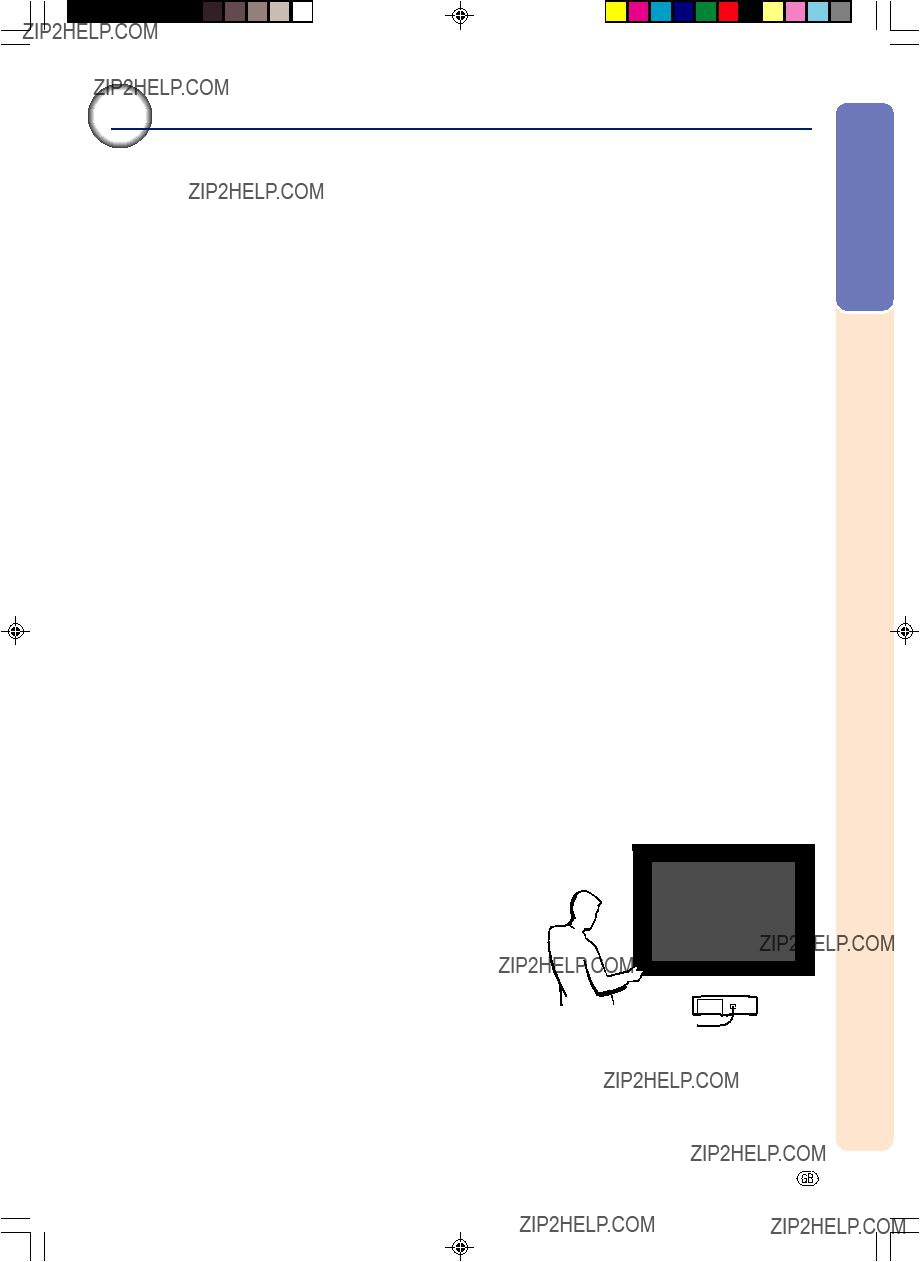
Outstanding Features
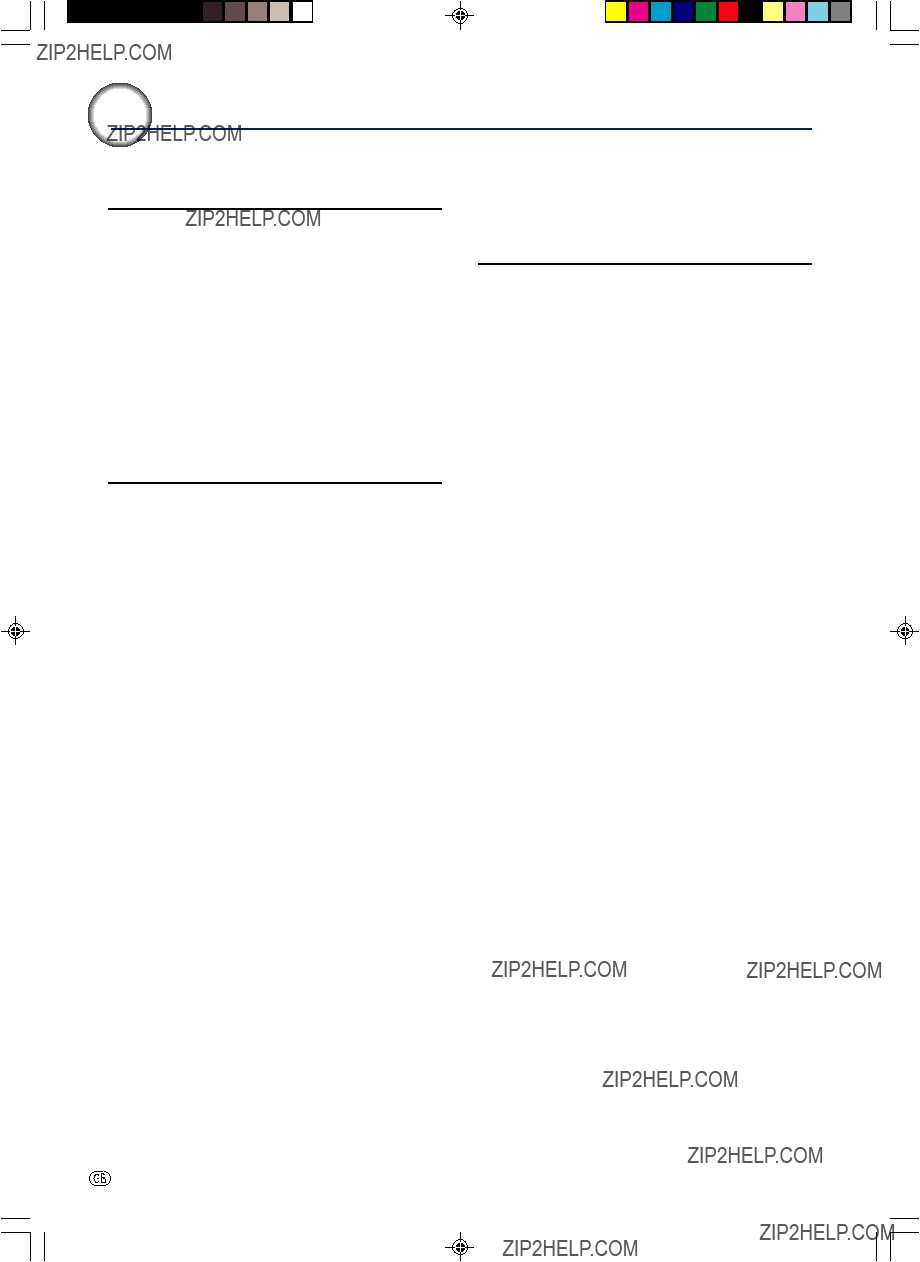
Contents

Introduction
 -5
-5
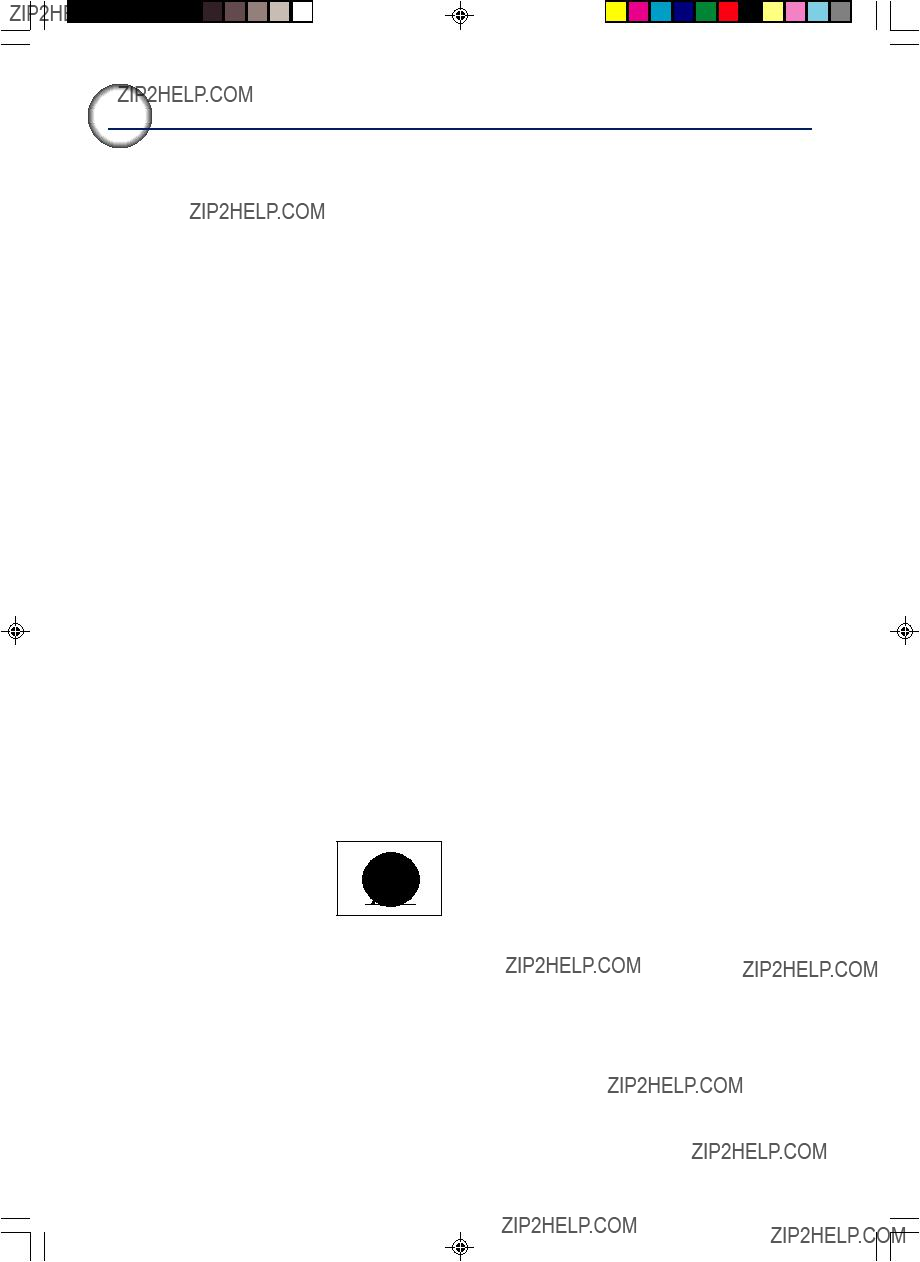
IMPORTANT SAFEGUARDS
CAUTION: Please read all of these instructions before you operate this product and save these instructions for later use.
Electrical energy can perform many useful functions. This product has been engineered and manufactured to assure your personal safety. BUT IMPROPER USE CAN RESULT IN POTENTIAL ELECTRICAL SHOCK OR FIRE HAZARDS. In order not to defeat the safeguards incorporated in this product, observe the following basic rules for its installation, use and servicing.
1.Read Instructions
All the safety and operating instructions should be read before the product is operated.
2.Retain Instructions
The safety and operating instructions should be retained for future reference.
3.Heed Warnings
All warnings on the product and in the operating instructions should be adhered to.
4.Follow Instructions
All operating and use instructions should be followed.
5.Cleaning
Unplug this product from the wall outlet before cleaning. Do not use liquid cleaners or aerosol cleaners. Use a damp cloth for cleaning.
6.Attachments
Do not use attachments not recommended by the product manufacturer as they may cause hazards.
7.Water and Moisture
Do not use this product near
8.Accessories
Do not place this product on an unstable cart, stand, tripod, bracket, or table. The product may fall, causing serious injury to a child or adult, and serious damage to the product. Use only with a cart, stand, tripod, bracket, or table recommended by the manufacturer, or sold with the product. Any mounting of the product should follow the manufacturer???s instructions, and should use a mounting accessory recommended by the manufacturer.
11.Power Sources
This product should be operated only from the type of power source indicated on the marking label. If you are not sure of the type of power supply to your home, consult your product dealer or local power company. For products intended to operate from battery power, or other sources, refer to the operating instructions.
12.Grounding or Polarization
This product is provided with one of the following types of plugs. If the plug should fail to fit into the power outlet, please contact your electrician.
Do not defeat the safety purpose of the plug.
a.
b.
This plug will only fit into a grounding type power outlet.
13.
14.Lightning
For added protection for this product during a lightning storm, or when it is left unattended and unused for long periods of time, unplug it from the wall outlet and disconnect the cable system. This will prevent damage to the product due to lightning and
15.Overloading
Do not overload wall outlets, extension cords, or integral convenience receptacles as this can result in a risk of fire or electric shock.
9. Transportation
A product and cart combination should be moved with care. Quick stops, excessive force, and uneven surfaces may cause the product and cart combination to overturn.
10.Ventilation
Slots and openings in the cabinet are provided for ventilation to ensure reliable operation of the product and to protect it from overheating, and these openings must not be blocked or covered. The openings should never be blocked by placing the product on a bed, sofa, rug, or other similar surface. This product should not be placed in a
16.Object and Liquid Entry
Never push objects of any kind into this product through openings as they may touch dangerous voltage points or
17.Servicing
Do not attempt to service this product yourself as opening or removing covers may expose you to dan- gerous voltage or other hazards. Refer all servicing to qualified service personnel.
 -6
-6
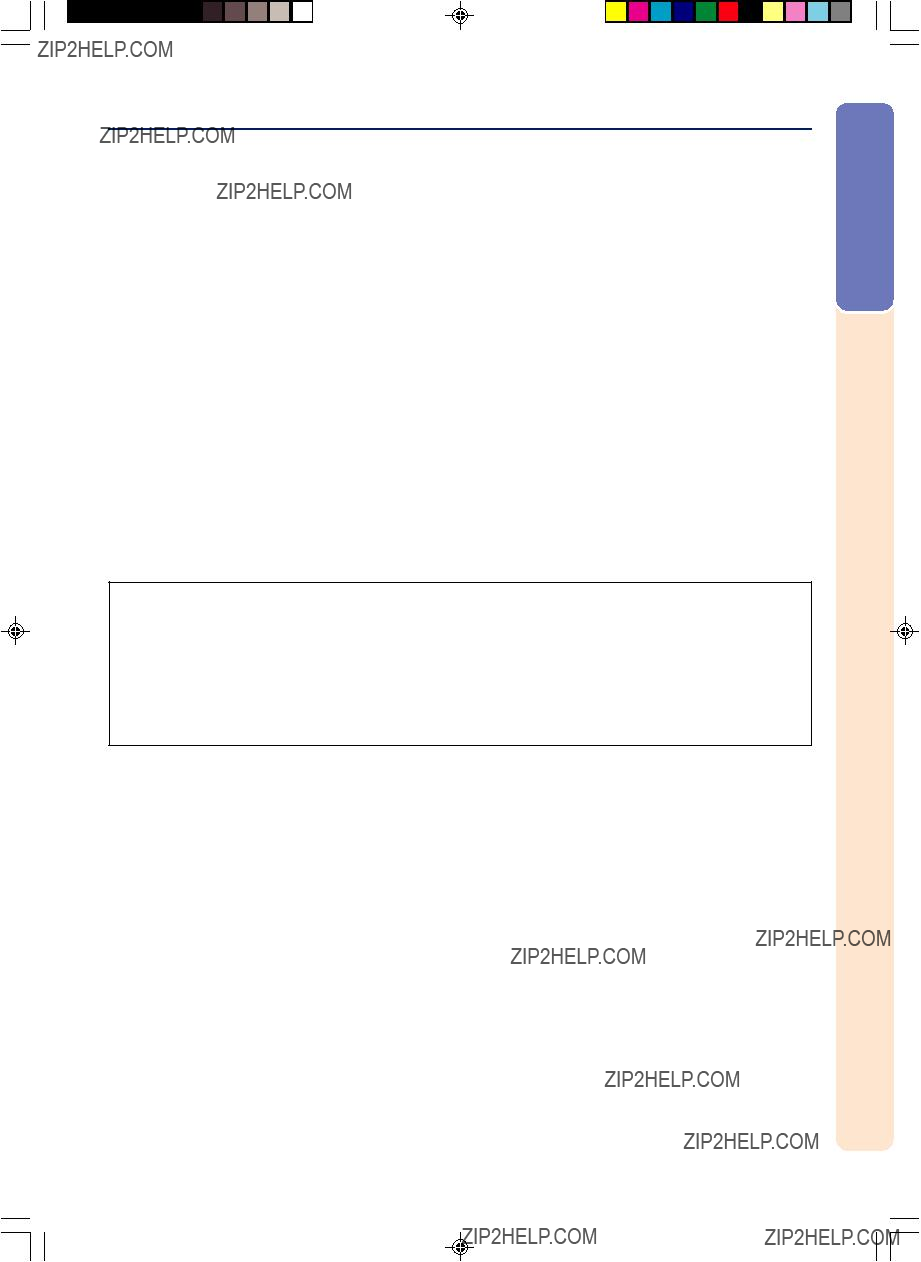
18.Damage Requiring Service
Unplug this product from the wall outlet and refer servicing to qualified service personnel under the following conditions:
a.When the
b.If liquid has been spilled, or objects have fallen into the product.
c.If the product has been exposed to rain or water.
d.If the product does not operate normally by following the operating instructions. Adjust only those controls that are covered by the operating instructions, as an improper adjustment of other controls may result in damage and will often require extensive work by a qualified technician to restore the product to normal operation.
e.If the product has been dropped or damaged in any way.
f.When the product exhibits a distinct change in performance, this indicates a need for service.
19.Replacement Parts
When replacement parts are required, be sure the service technician has used replacement parts specified by the manufacturer or have the same characteristics as the original part. Unauthorized substitutions may result in fire, electric shock, or other hazards.
20.Safety Check
Upon completion of any service or repairs to this product, ask the service technician to perform safety checks to determine that the product is in proper operating condition.
21.Wall or Ceiling Mounting
This product should be mounted to a wall or ceiling only as recommended by the manufacturer.
22.Heat
This product should be situated away from heat sources such as radiators, heat registers, stoves, or other products (including amplifiers) that produce heat.
Introduction
???Microsoft and Windows are registered trademarks of Microsoft Corporation in the United States and/or other countries.
???PC/AT is a registered trademark of International Business Machines Corporation in the United States.
???Adobe Acrobat is a trademark of Adobe Systems Incorporated.
???Macintosh is a registered trademark of Apple Computer, Inc. in the United States and/or other countries.
???All other company or product names are trademarks or registered trademarks of their respective compa- nies.
 -7
-7

IMPORTANT SAFEGUARDS
Be sure to read the following safeguards when setting up your projector.
Caution concerning the lamp unit
??? Potential hazard of glass particles if lamp ruptures. In case of lamp rupture, contact your nearest Sharp Authorized Projector Dealer or Service Center for a replacement.
See ???Replacing the Lamp??? on page 57.
Caution concerning the setup of the projector
???For minimal servicing and to maintain high image qual- ity, SHARP recommends that this projector be installed in an area free from humidity, dust and cigarette smoke. When the projector is subjected to these environments, the lens must be cleaned more often. As long as the projector is regularly cleaned, use in these environ- ments will not reduce the overall operation life of the unit. Internal cleaning should only be performed by a
Sharp Authorized Projector Dealer or Service Center.
???Be sure that the intake vent and the exhaust vent are not obstructed.
???If the cooling fan becomes obstructed, a protection cir- cuit will automatically put the projector into the standby mode. This does not indicate a malfunction. Remove the projector power cord from the wall outlet and wait at least 10 minutes. Place the projector where the intake and exhaust vents are not blocked, plug the power cord back in and turn on the projector. This will return the projector to the normal operating condition.
Caution regarding transportation of the projec- tor
???When transporting the projector, be sure not to subject it to hard impact and/or vibration, as this can result in damage. Take extra care with the lens. Before moving the projector, be sure to unplug the power cord from the wall outlet, and disconnect any other cables con- nected to it.
Do not set up the projector in places exposed to direct sunlight or bright light.
???Position the screen so that it is not in direct sunlight or room light. Light falling directly on the screen washes out the colors, making viewing difficult. Close the cur- tains and dim the lights when setting up the screen in a sunny or bright room.
The projector may be safely tilted to a maximum angle of 12 degrees.
??? Placement should be within ??12 degrees of horizontal.
Do not subject the projector to hard impact and/ or vibration.
???Take care with the lens so as not to hit or damage the surface of the lens.
Rest your eyes occasionally.
???Continuously watching the screen for long hours will cause eye strain. Be sure to occasionally rest your eyes.
Avoid locations with extremes of temperature.
???The operating temperature of the projector is from 41??F to 95??F (+5??C to +35??C).
???The storage temperature of the projector is from
Do not block the exhaust and intake vents.
???Allow at least 7 7/8 inches (20 cm) of space between the exhaust vent and the nearest wall or obstruction.
 -8
-8
Other connected equipment
???When connecting a computer or other
TER unplugging the power cord of the projector from the AC outlet and turning off the equipment to be con- nected.
???Please read the operation manuals of the projector and the equipment to be connected for instructions on how to make the connections.
Using the projector in other countries
???The power supply voltage and the shape of the plug may vary depending on the region or country you are using the projector in. When using the projector over- seas, be sure to use an appropriate power cord for the country you are in.
Temperature monitor function
???If the projector starts to overheat
due to setup problems or block-
age of the air vents, ???  ??? and
??? and
???  ??? will illuminate in the lower left corner of the picture. If the temperature continues to rise, the lamp
??? will illuminate in the lower left corner of the picture. If the temperature continues to rise, the lamp
will turn off, the temperature warning indicator on the projector will blink, and after a
 Info
Info
???The cooling fan regulates the internal temperature, and its performance is automatically controlled. The sound of the fan may change during projector operation due to changes in the fan speed. This does not indicate malfunction.
???Do not unplug the power cord during projection or cool- ing fan operation. This can cause damage due to rise in internal temperature, as the cooling fan also stops.

How to Access the PDF Operation Manuals
PDF operation manuals in several languages are included in the
Introduction
To install Acrobat Reader from the
For Windows:
1 Insert the
3 Double click the
5Double click the language (name of the folder) that you want to view.
6Double click the installation program and follow the instructions on the screen.
For Macintosh:
1 Insert the
3 Double click the ???ACROBAT??? folder.
4Double click the language (name of the folder) that you want to view.
5Double click the installation program and follow the instructions on the screen.
For other operating systems:
Please download Acrobat Reader from the Internet (http://www.adobe.com).
For other languages:
If you prefer using Acrobat Reader for languages other than those included in the
Accessing the PDF Manuals
For Windows:
1 Insert the
3 Double click the
5 Double click the language (name of the folder) that you want to view.
6Double click the ???A20??? pdf file to access the projector manuals.
For Macintosh:
1 Insert the
3 Double click the ???MANUALS??? folder.
4 Double click the language (name of the folder) that you want to view.
5Double click the ???A20??? pdf file to access the projector manuals.
 Note
Note
???If the desired pdf file cannot be opened by double clicking the mouse, start Acrobat Reader first, then specify the desired file using the ???File???, ???Open??? menu.
???See the ???readme.txt??? file on the
 -9
-9

Part Names
Numbers in  refer to the main pages in this operation manual where the topic is explained.
refer to the main pages in this operation manual where the topic is explained.
Projector (Front and Top View)
Power indicator
Illuminates red when the projector is in standby.
When the power is turned on, this indicator will illuminate green.
ON button
For turning the power on.
STANDBY button
For putting the projector into the standby mode.
KEYSTONE button
For entering the Keystone Correction mode.
AUTO SYNC button
For automatically adjusting images when connected to a computer.
Remote control 13 sensor
Exhaust vent 52
26
26
28
29 

39 

55Lamp indicator
Illuminates green indicating normal function. Replace the lamp when the indicator illuminates red.
55Temperature warning indicator
When the internal temperature rises, this indicator will illuminate red.
27INPUT button
For switching input mode 1, 2 or 3.
27Volume buttons
For adjusting the speaker sound level or the Keystone Correction.
22 Zoom knob
Front adjustment foot 21
Attaching and removing the lens cap
???Press on the two buttons of the lens cap and attach it to the lens, then release the buttons to lock it in place.
???Press on the two buttons of the lens cap and remove it from the lens.
fan (Intake vent) (on the bottom of the projector)
In this operation manual, the illustration and the screen display are simplified for explanation, and may differ slightly from actual display.
 -10
-10

Projector (Rear View)
INPUT 1 terminal 16
Terminal for computer RGB and component signals.
For controlling the projector using a computer.
Kensington Security
Standard connector
Using the Kensington Lock
???This projector has a Kensington Security Stan- dard connector for use with a Kensington MicroSaver
Security System. Refer to the information that came with the system for instruc- tions on how to use it to se- cure the projector.
18INPUT 3 terminal
Terminal for connecting video equipment.
16AUDIO INPUT terminal
Shared audio input terminal for INPUT 1, 2 and 3.
52 Intake vent
15 AC socket
21Rear adjustment foot
(on the bottom of the projector)
 -11
-11

Part Names
Numbers in  refer to the main pages in this operation manual where the topic is explained.
refer to the main pages in this operation manual where the topic is explained.
Remote Control (Front View)
ON button
For turning the power on.
MENU button
For displaying adjustment and setting screens.
Adjustment buttons (', ", \, |)
For selecting menu items.
ENTER button
For setting items selected or adjusted on the menu.
FREEZE button
For freezing images.
AV MUTE button
For temporarily displaying the black screen and turning off the sound.
RESIZE button
For switching the screen size (NORMAL, BORDER, etc).
Volume buttons
For adjusting the speaker sound level.
 -12
-12
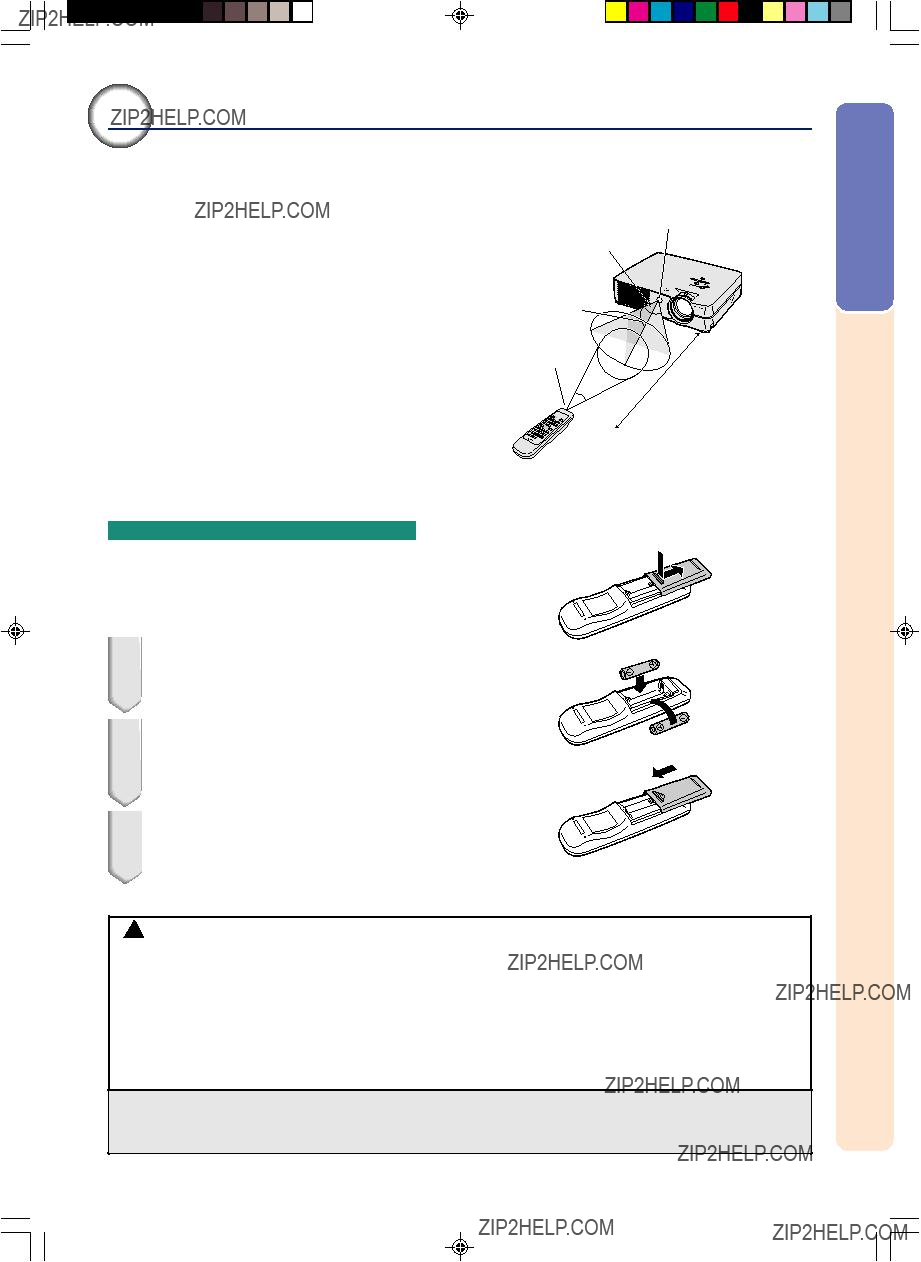
Using the Remote Control
Usable Range
???The remote control can be used to control the projector within the ranges shown in the illustration.
 Note
Note
???The signal from the remote control can be re- flected off a screen for easy operation. How- ever, the effective distance of the signal may differ depending on the screen material.
When using the remote control:
???Be sure not to drop, expose to moisture or high temperature.
???The remote control may malfunction under a fluorescent lamp. In this case, move the pro- jector away from the fluorescent lamp.
Remote control sensor
45??
30??
Remote control signal transmitters
Remote control
Introduction
Inserting the Batteries
The batteries (two
1 Press the ??? mark on the cover and slide it in the direction of the arrow.
2 Insert the batteries.
???Insert the batteries making sure the po- larities correctly match the  and
and 
marks inside the battery compartment.
3 Attach the cover and slide it un- til it clicks into place.
Incorrect use of the batteries may cause them to leak or explode. Please follow the precautions below.
 Caution
Caution
???Insert the batteries making sure the polarities correctly match the  and
and  marks inside the battery compart- ment.
marks inside the battery compart- ment.
???Batteries of different types have different properties, therefore do not mix batteries of different types.
???Do not mix new and old batteries.
This may shorten the life of new batteries or may cause old batteries to leak.
???Remove the batteries from the remote control once they have run out, as leaving them in can cause them to leak. Battery fluid from leaked batteries is harmful to skin, therefore be sure to first wipe them and then remove them using a cloth.
???The batteries included with this projector may run down in a short period, depending on how they are kept. Be sure to replace them as soon as possible with new batteries.
???Remove the batteries from the remote control if you will not be using the remote control for a long time.
 -13
-13
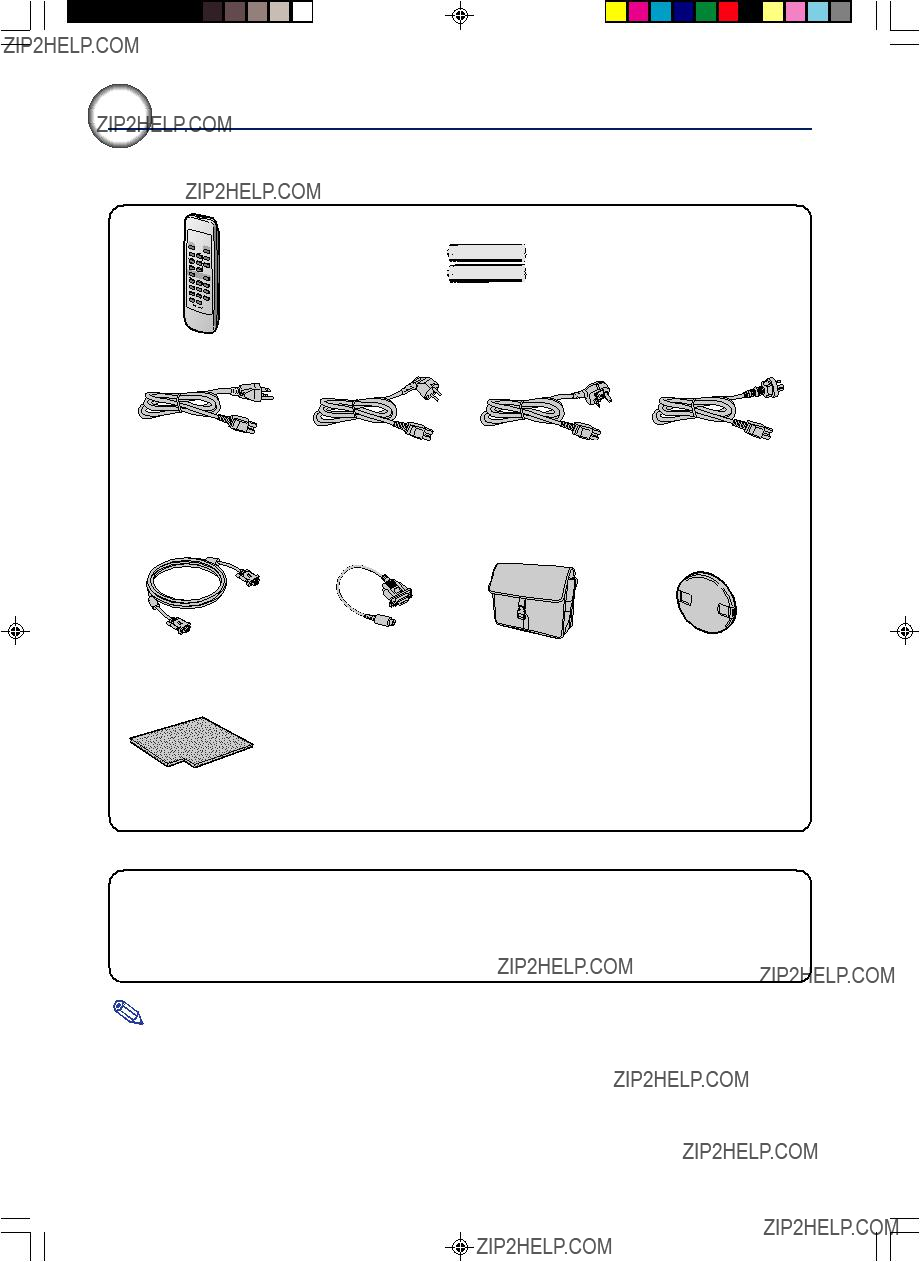
Accessories
Supplied accessories
Remote control
RRMCGA187WJSA
Two
(???AA??? size,
*Use the power cord that corresponds to the wall outlet in your country.
Optional accessories
???3 RCA to
???Computer RGB cable (32'10'' (10.0 m))
???5 BNC to
???
???Remote receiver
Note
???Some of the cables may not be available depending on the region. Please check with your nearest Sharp Authorized Projector Dealer or Service Center.
 -14
-14

Connecting the Projector to Other Devices
Before Connecting
 Note
Note
???Before connecting, be sure to unplug the power cord of the projector from the AC outlet and turn off the devices to be connected. After making all connections, turn on the projector and then the other devices. When connecting a computer, be sure that it is the last device to be turned on after all the connections are made.
???Be sure to read the operation manuals of the devices to be connected before making connections.
This projector can be connected to:
A computer using:
??? An RGB cable and a ??3.5 mm audio cable (commercially available) (See page 16.)
??? A
Component video or
??? A VCR, Laser disc player or other
??? A DVD player or DTV* decoder (See page 19.)
*DTV is the umbrella term used to describe the new digital television system in the United States.
and Connections
Setup
Connecting the Power
Cord
Plug the supplied power cord into the AC socket on the rear of the pro- jector.
 -15
-15

Connecting the Projector to Other Devices
Connecting the Projector to a Computer
Connecting to a Computer Using the RGB Cable
1 Connect the projector to the computer using the supplied RGB cable.
???Secure the connectors by tightening the thumbscrews.
2 To input an audio signal, connect the projector to the computer using a ??3.5 mm audio cable (commer- cially available or available as Sharp service part QCNWGA013WJPZ).
 Note
Note
???When connecting the projector to a com- puter in this way, select ???RGB??? for ???Signal Type??? in the ???Picture??? menu. See page 37.
???See page 62 ???Computer Compatibility Chart??? for a list of computer signals com- patible with the projector. Use with computer signals other than those listed may cause some of the functions to not work.
???A Macintosh adaptor may be required for use with some Macintosh computers. Con- tact your nearest Sharp Authorized Projec- tor Dealer or Service Center.
???Depending on the computer you are using, an image may not be projected unless the signal output setting of the computer is switched to the external output. Refer to the computer operation manual for switching the computer signal output settings.
Supplied
RGB cable
accesso- ries
Computer
To RGB output terminal
To audio output terminal
1RGB cable
2??3.5 mm audio cable (commercially available or available as Sharp service part QCNWGA013WJPZ)
Connecting the thumbscrew cables
??? Connect the thumbscrew cable making sure that it fits correctly into the terminal. Then, firmly secure the connectors by tightening the screws on both sides of the plug.
??? Do not remove ferrite cores attached to the RGB cable.
Ferrite core
 -16
-16
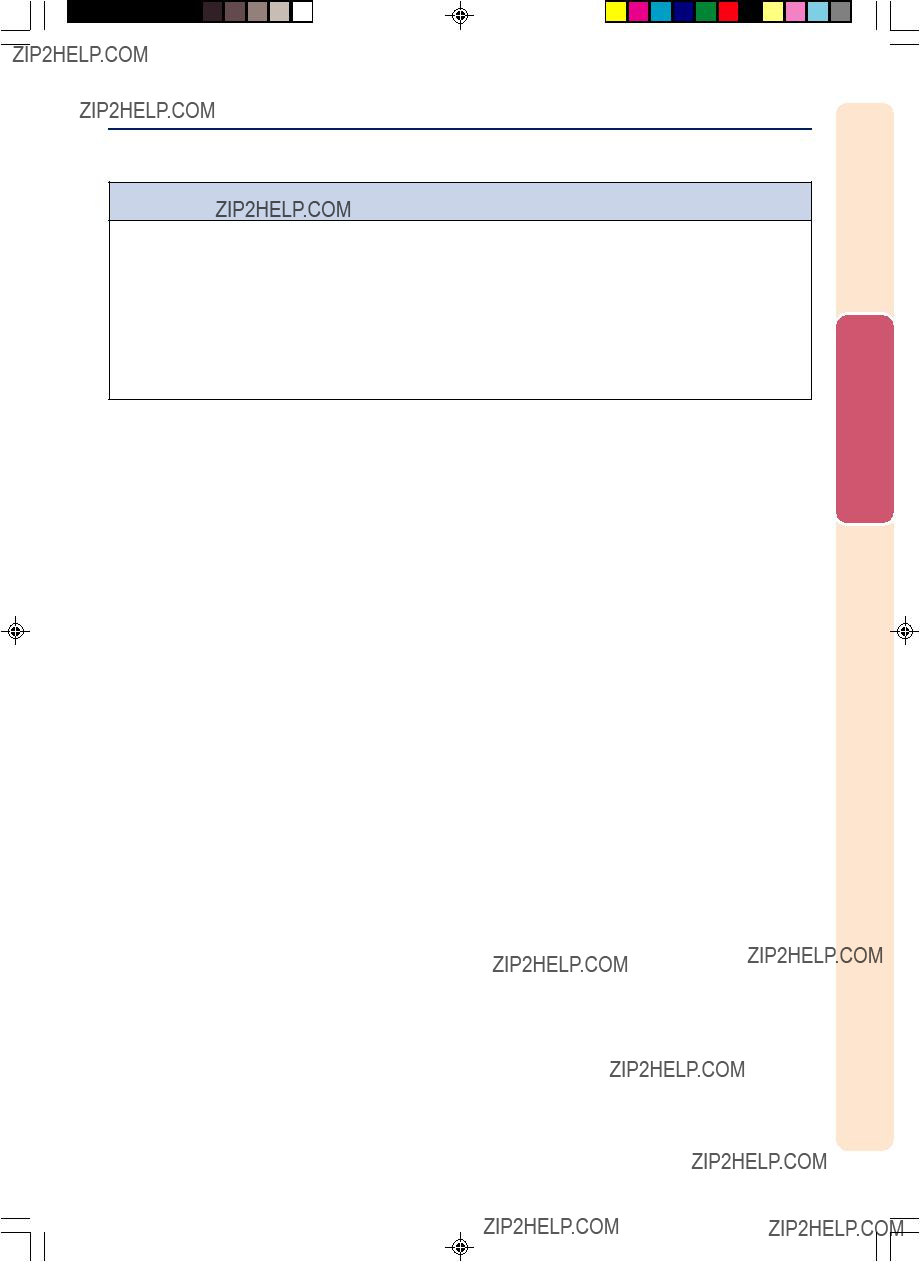
???Plug and Play??? function (when connecting to a
???This projector is compatible with
???Before using the ???Plug and Play??? function, be sure to turn on the projector first and the connected computer last.
 Note
Note
???The DDC ???Plug and Play??? function of this projector operates only when used in conjunction with a VESA DDC compatible computer.
 -17
-17
and Connections
Setup

Connecting the Projector to Other Devices
Connecting to Video Equipment
Connecting to Video Equipment Using an
Using an
1 Connect the projector to the video equipment using an S- video cable or a composite video cable (both commercially avail- able).
2 Connect the projector to the video equipment using a ??3.5 mm minijack to RCA audio cable (commercially available).
 Note
Note
???The INPUT 2
???A ??3.5 mm minijack to RCA audio cable (commercially available) is required for au- dio input.
VCR or other
To
To video output terminal
To audio output terminal
2??3.5 mm minijack to RCA audio cable (commercially available)
1Composite video cable (commercially available)
(commercially available)
 -18
-18

Connecting to Component Video Equip- ment
Use a 3 RCA to
*DTV is the umbrella term used to describe the new digital television system in the United States.
1 Connect the projector to the video equipment using the 3 RCA to
2 Connect the projector to the video equipment using a ??3.5 mm minijack to RCA audio cable (commercially available).
 Note
Note
???When connecting the projector to the video equipment in this way, select ???Component??? for ???Signal Type??? in the ???Picture??? menu. See page 37.
???A ??3.5 mm minijack to RCA audio cable (commercially available) is required for au- dio input.
To analog component output terminal
To audio output terminal
DVD player or
DTV* decoder
13 RCA to
2??3.5 mm minijack to RCA audio cable (commercially available)
and Connections
Setup
 -19
-19

Connecting the Projector to Other Devices
Controlling the Projector Using a Computer
Connecting to a Computer Using a
When the
1 Connect the supplied
2 Use the above cables to connect the projector and the computer.
 Note
Note
???Do not connect or disconnect an
???The
???See page 60 for connection of an



To
 -20
-20

Setup
Using the Adjustment
Feet
The height of the projector can be adjusted us- ing the adjustment feet at the front and rear of the projector when the surface the projector is placed on is uneven or when the screen is slanted.
The projection of the image can be made higher by adjusting the projector when it is in a lower place than the screen.
1 While pressing the foot releases on both sides, lift the projector to adjust its height and then re- move your fingers from the foot releases.
2 Rotate the adjustment feet at the front of the projector for fine adjustment.
???You can adjust the projection by using the rear adjustment foot on the bottom of the projector when the projector is po- sitioned at the higher place than the screen.
 Note
Note
???The Keystone Correction will be automatically performed when the projector is tilted. If you want to adjust the Keystone Correction manually, see page 29. (For details on set- ting of the Keystone Correction, see page 44.)
???When returning the projector to its original position, hold the projector firmly, press the foot releases and then gently lower it.
???The projector is adjustable up to approxi- mately 12 degrees at the front and 3 degrees at the back from the standard position.
 Info
Info
???Do not press the foot releases when the ad- justment feet are extended without firmly holding the projector.
???Do not hold the lens when lifting or lower- ing the projector.
???When lowering the projector, be careful not to get your fingers caught in the area between the adjustment foot and the projector.
Rear adjustment foot (on the bottom)
 -21
-21
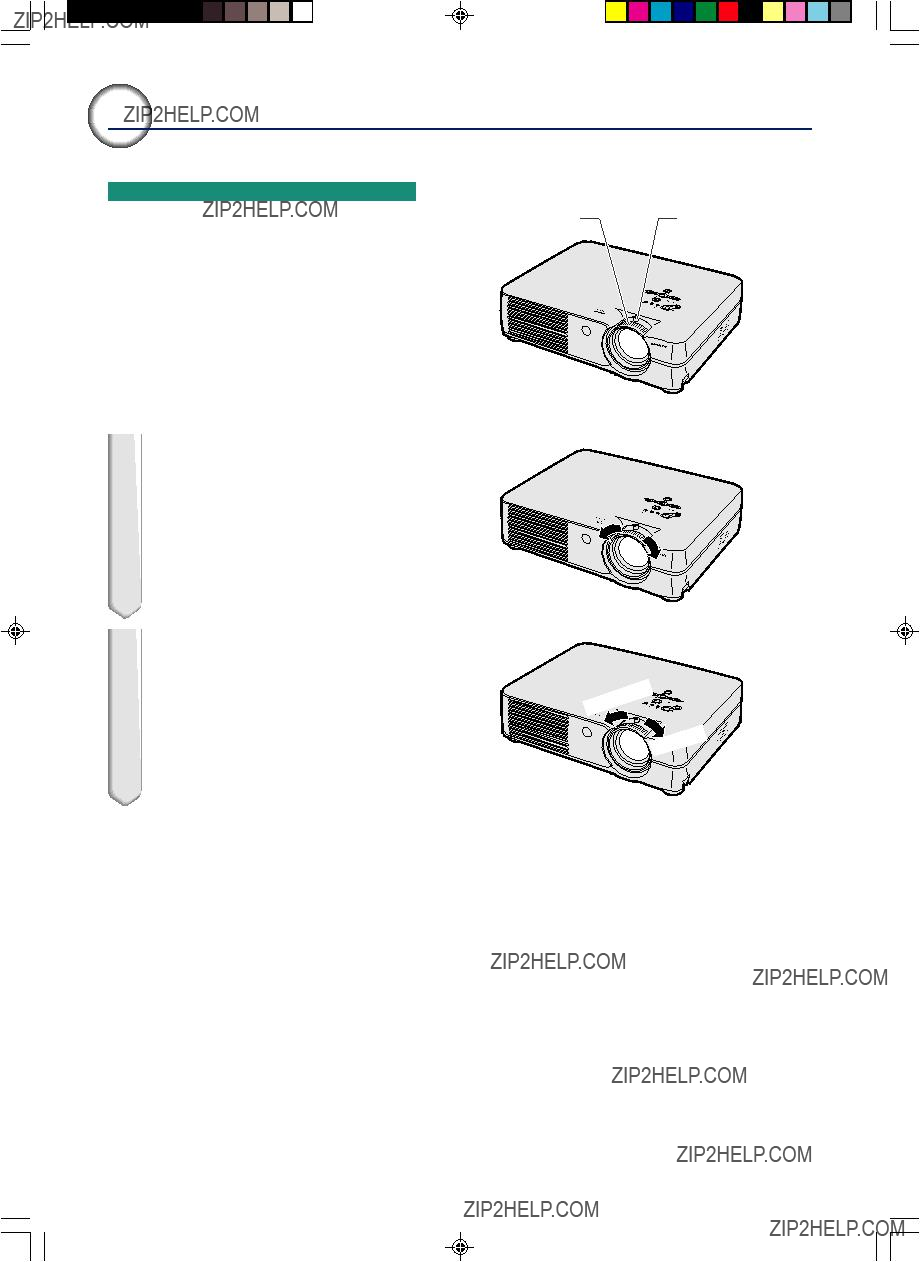
Setup
Adjusting the Lens
The image is focused and adjusted to the de- sired size using the focus ring or zoom knob on the projector.
1
2
Adjust the focus by rotating the focus ring.
Adjust zooming by moving the zoom knob.
 -22
-22
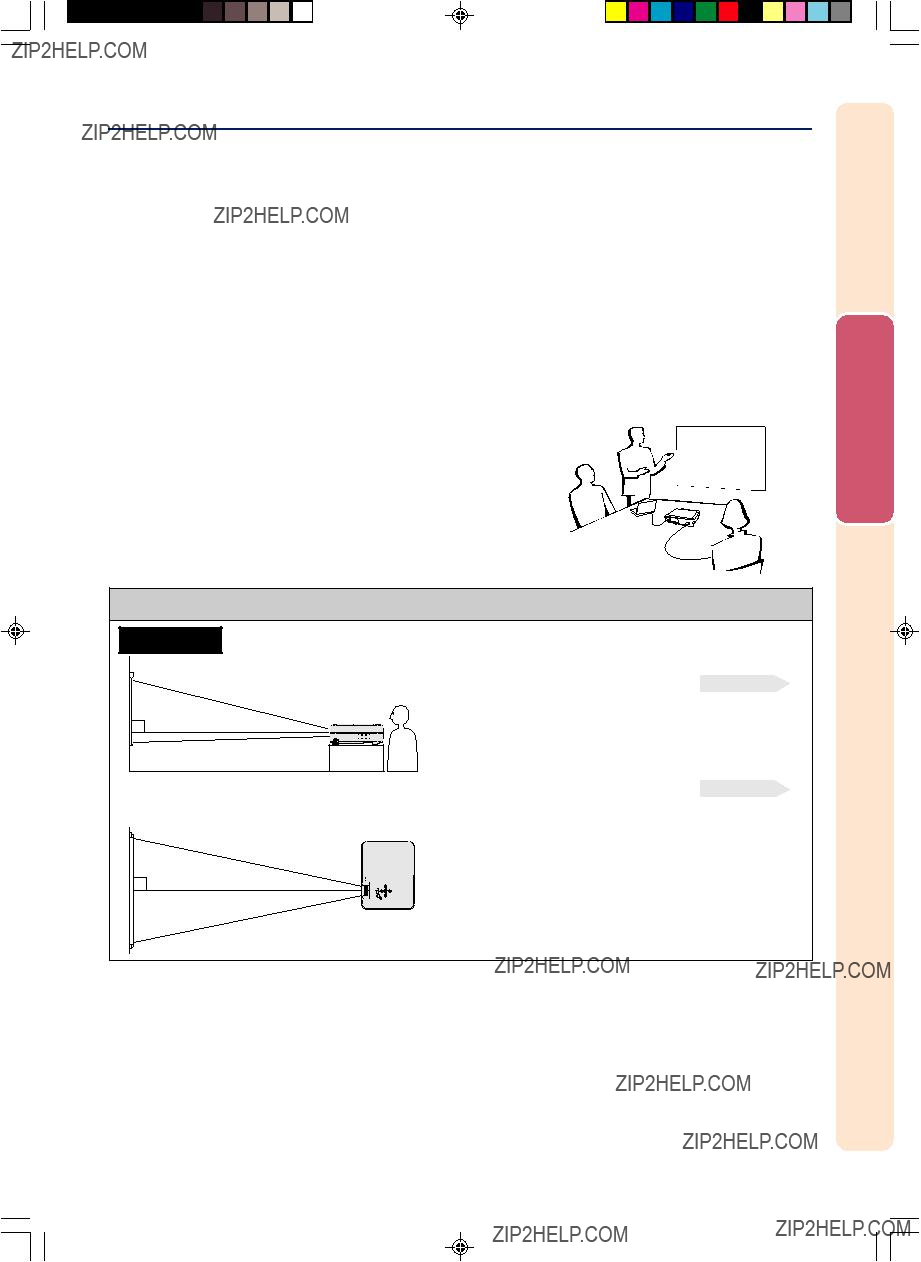
Setting up the Screen
Position the projector perpendicular to the screen with all feet flat and level to achieve an optimal image.
 Note
Note
???The projector lens should be centered in the middle of the screen. If the horizontal line passing through the lens center is not perpendicular to the screen, the image will be distorted, making viewing difficult.
???For an optimal image, position the screen so that it is not in direct sunlight or room light. Light falling directly on the screen washes out the colors, making viewing difficult. Close the curtains and dim the lights when setting up the screen in a sunny or bright room.
???A polarizing screen cannot be used with this projector.
Standard Setup (Front Projection)
???Place the projector at the required distance from the screen according to the desired picture size. (See page 24.)
and Connections
Setup
Example of standard setup
Side View
???The distance from the screen to the projector may vary depending on the size of the screen.
P.24
???The default setting can be used, when placing the projector in front of the screen. If the projected im-
age is reversed or inverted, readjust the setting to
 -23
-23

Setup
Screen Size and Projection Distance
NORMAL Mode (4:3)
STRETCH Mode (16:9)
The formula for picture size and projection distance
??: Picture size (diag.) (in)
[Feet, inches]
L1 (ft) = (0.0364?? ??? 0.06) / 0.3048
L2 (ft) = (0.0434?? ??? 0.06) / 0.3048 H (in) = ??? 0.0158??
[m, cm]
L1 (m) = 0.0364?? ??? 0.06
L2 (m) = 0.0434?? ??? 0.06
H (cm) = ??? 0.0158?? ??? 2.54
 Note
Note
???There may be an error of ?? 3% in the above values.
???Values with a minus
 -24
-24

Projecting a Reversed/Inverted Image
Projection from behind the Screen
???Place a translucent screen between the projector and the audience.
???Reverse the image by setting ???Rear??? in the ???PRJ Mode??? menu. See page 50 for use of this function.
Projection Using a Mirror
??? Place a mirror (normal flat type) in front of the lens.
 Info
Info
???When using a mirror, be sure to carefully position both the projector and the mirror so the light does not shine into the eyes of the audience.
When using the default setting.
The image is reversed.
and Connections
Setup
???It is recommended that you use the optional Sharp ceiling- mount bracket for this installation.
Before mounting the projector, contact your nearest Sharp Authorized Projector Dealer or Service Center to obtain the recommended
???
???
???
???Be sure to adjust the position of the
projector to match the distance (H) from the lens center position (see page 24) to the lower edge of the image, when mounting the projector on the ceiling.
??? Invert the image by setting ???Ceiling+Front??? in the ???PRJ Mode??? menu. See page 50 for use of this function.
When using the default setting.
The image is inverted.
 -25
-25
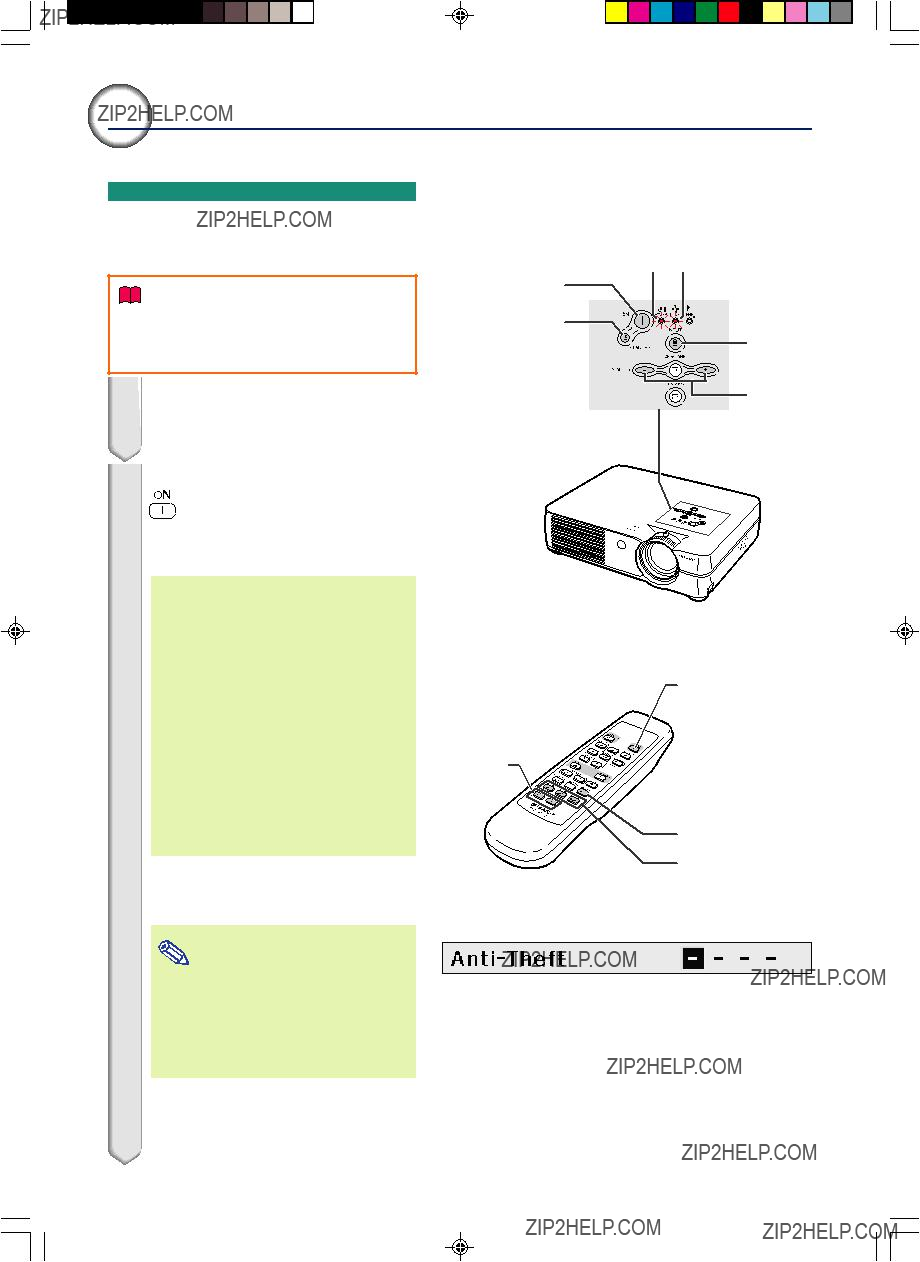
Image Projection
Basic Procedure
Connect the required external equipment to the pro- jector before carrying out the following procedures.
 Info
Info
???The language preset at the factory is English. If you want to change the
1 Plug the power cord into the wall outlet.
???The power indicator illuminates red, and the projector enters standby mode.
2 Press 
 on the projector or on the remote control.
on the projector or on the remote control.
???The power indicator illuminates green. After the lamp indicator illuminates, the projector is ready to start operation.
 Note
Note
???The lamp indicator illuminates, indicating the status of the lamp.
Green: The lamp is ready.
Blinking in green: The lamp is warming
up or shutting down.
Red: The lamp should be replaced.
ON button
STANDBY button
Volume buttons
Power Lamp indicator indicator
INPUT button
Volume
buttons
ON button
AV MUTE button
INPUT buttons
???Keycode input box
 -26
-26

3 Press  ,
,  or
or  on the remote control to select the IN- PUT mode.
on the remote control to select the IN- PUT mode.
???After pressing  once on the projector, use
once on the projector, use  to select the desired input mode.
to select the desired input mode.
 Note
Note
???When no signal is received, ???NO SIG- NAL??? will be displayed. When a signal that the projector is not preset to re- ceive is received, ???NOT REG.??? will be displayed.
???The INPUT mode is not displayed when ???OSD Display??? is set to ???OFF???. (See page 45.)
About the INPUT mode
4 Press  or
or  on the remote control to adjust the volume.
on the remote control to adjust the volume.
Note
???Pressing  will lower the volume. Pressing
will lower the volume. Pressing  will raise the volume.
will raise the volume.
???On the projector, the volume can be adjusted by pressing  or
or  .
.
5 Press  on the remote con- trol to temporarily display a black screen and turn off the sound.
on the remote con- trol to temporarily display a black screen and turn off the sound.
 Note
Note
???Pressing  again will turn the pro- jected image and sound back on.
again will turn the pro- jected image and sound back on.
Using
Component
Operation Basic
 -27
-27
03.4.23, 9:57 AM
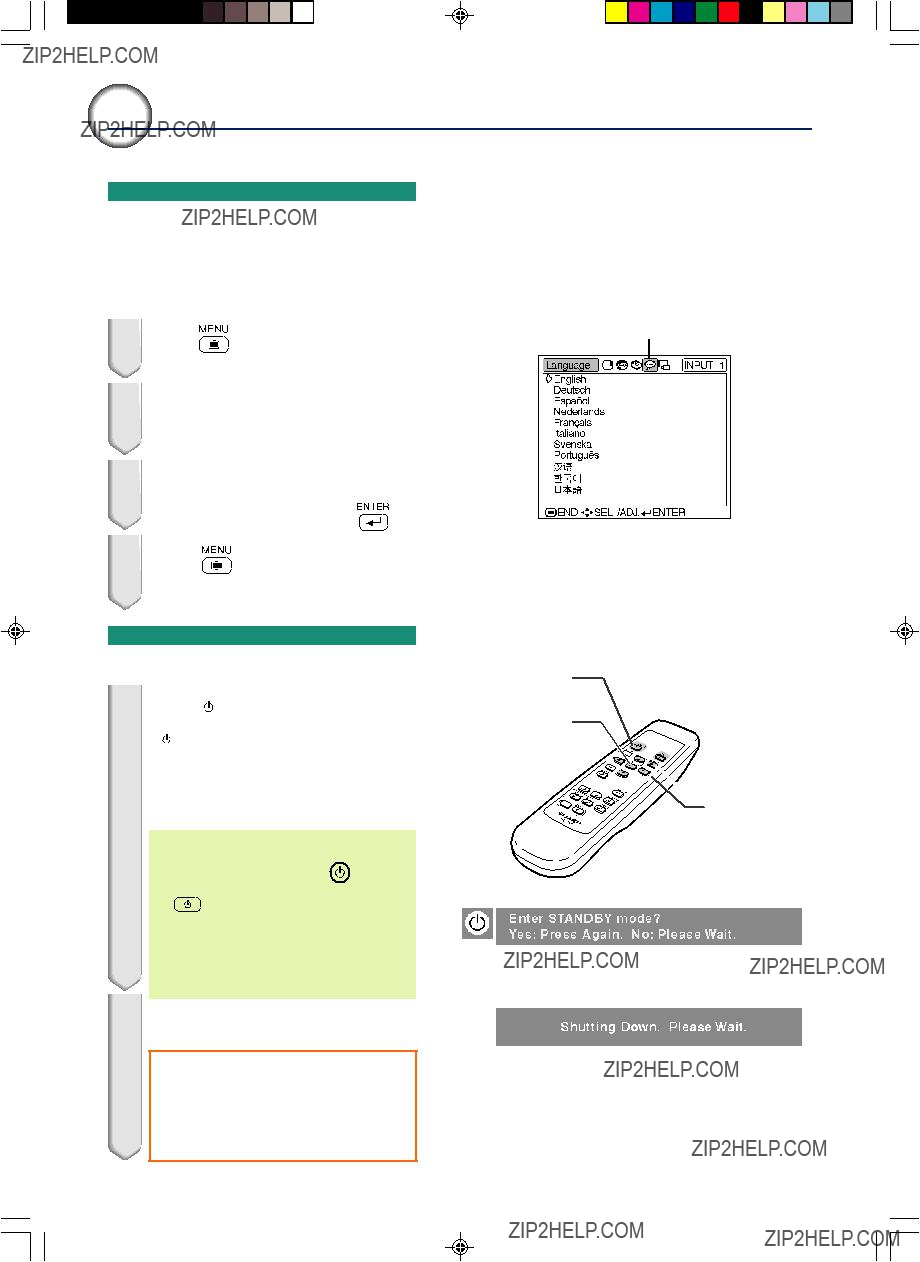
Image Projection
Selecting the
Display Language
The
??? The ???Picture??? menu will be displayed.
2 Press \or | to select the ???Lan- guage??? menu icon.
??? The ???Language??? menu will be displayed.
3 Press 'or "to select the desired
???Language??? menu icon
language, and then press
4 Press .
.
???The desired language will be set as the
Turning the Power off
1 Press STANDBY on the projector or
STANDBY on the projector or
STANDBY
 on the remote control, then press that button again while the confirmation message is dis- played, to put the projector into the standby mode.
on the remote control, then press that button again while the confirmation message is dis- played, to put the projector into the standby mode.
 Note
Note
STANDBY
and do not want to put the projector
into the standby mode, wait until the con- firmation message disappears.
???The projector cannot be operated while a message ???Shutting Down. Please Wait.??? is displayed.
2 Unplug the power cord from the AC outlet after the cooling fan stops.
 Info
Info
???Do not unplug the power cord during pro- jection or cooling fan operation. This can cause damage due to rise in internal tem- perature, as the cooling fan also stops.
 -28
-28
STANDBY button
ENTER
button




 MENU button
MENU button
', ", \, |
buttons

Keystone Correction (Correcting Trapezoidal Distortion)
Correcting Trapezoidal
Distortion
This function allows for Keystone
 Note
Note
???When the image is projected either from the top or from the bottom towards the screen at an angle, the image becomes distorted trapezoidally.
The function for correcting trapezoidal dis-
tortion is called Keystone Correction.
???You can select ???Auto??? or ???Manual??? for the Keystone Correction mode. (See page 44.)
???The Keystone Correction can be adjusted up to an angle of approximately ??12?? when the Keystone Correction mode is set to ???Auto???, or approximately ??35?? when set to ???manual??? (when the picture display mode is set to ???NORMAL??? (see page 40)). Therefore, the actual screen can be diagonally set up to that angle as well.
1 Press  .
.
??? You can also use  on the projector.
on the projector.
2 Press ', ", \ and | to adjust the Keystone correction.
???You can also adjust the Keystone cor-
rection using the  or
or  but- tons on the projector.
but- tons on the projector.
 Note
Note
???Press  to make the default set- ting.
to make the default set- ting.
???Straight lines or the edges of images may appear jagged while adjusting the image.
KEYSTONE button
UNDO

 button
button 








', ", \, |
buttons
Compresses upper side.
Compresses lower side.
Operation Basic
3 Press  .
.
???You can also use  on the projector.
on the projector.
 Note
Note
???You can use the same settings used in NORMAL mode 4:3 for 16:9.
 -29
-29

Menu Items
This list shows the items that can be set in the projector.
??? INPUT 1 Mode
 Note
Note
???In the ???Picture??? menu of INPUT 1, ???Color???, ???Tint??? and ???Sharp??? are only displayed when ???Signal Type??? is set to ???Component??? or set to ???Auto??? and the input signal is recognized as a component signal.
???In the ???Picture??? menu of INPUT 1, ???sRGB??? is only displayed when ???Signal Type??? is set to ???RGB??? or set to ???Auto??? and the input signal is recognized as an RGB signal.
 -30
-30
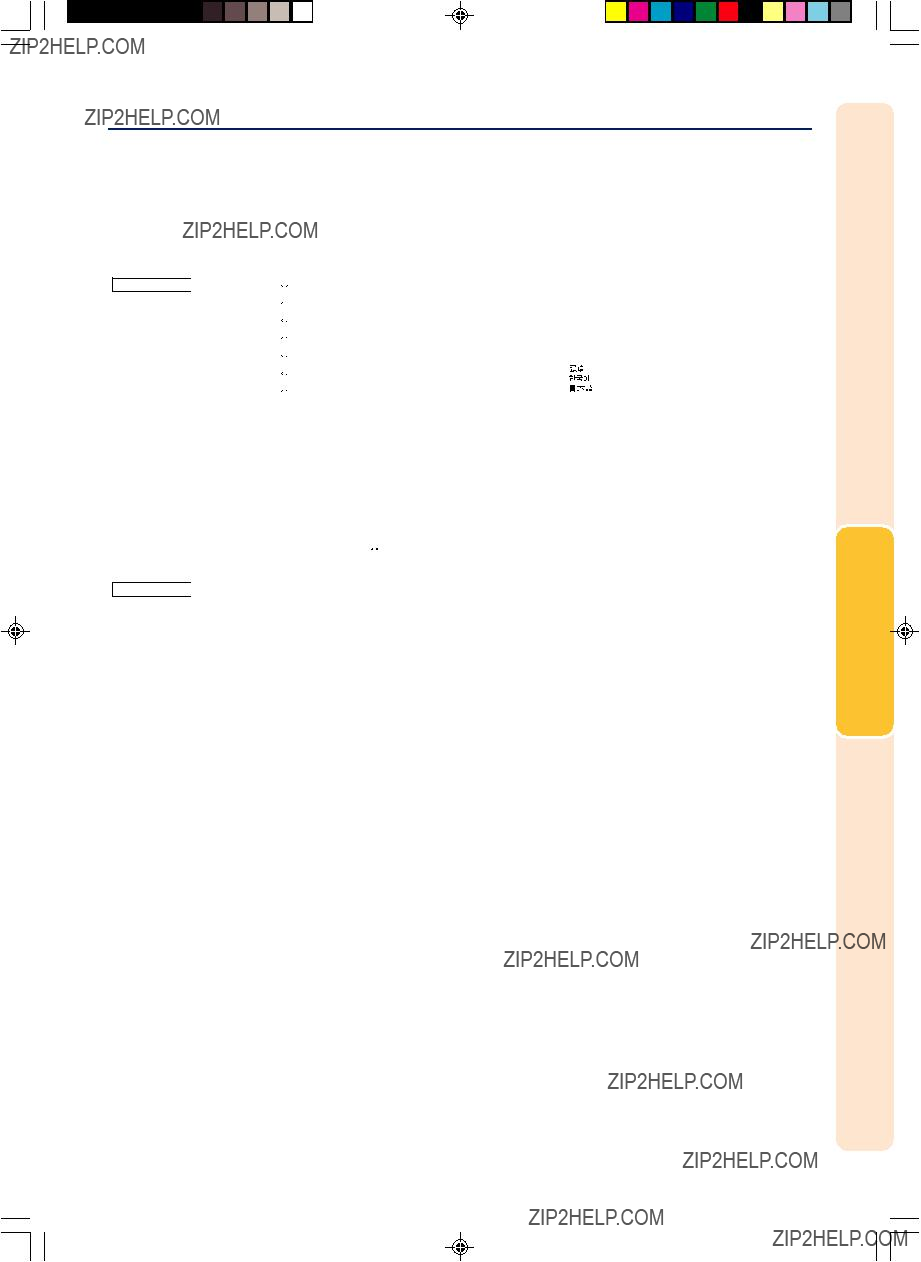
??? INPUT 2 / 3 Mode
Main menu
Picture
Page 36
Options
Page 44
Main menu
Operation Basic
 -31
-31

Using the Menu Screen
The menu screens allow you to adjust the image and various projector settings. You can operate the menus from the remote control using the following procedure.
Example: ???Picture??? menu screen for
INPUT 1 (RGB) mode
Menu Selections
(Adjustments)
 Note
Note
???The
MENU button
', ", \, |
buttons
???The menu icon for the selected menu screen is highlighted.
Fine Sync
Options
Language
PRJ Mode
 Note
Note
???The ???Fine Sync??? menu is not available for INPUT 2 or 3.
???For details on the menus, see the tree charts on pages 30 and 31.
 -32
-32

3 Press ' or " to select the item you want to adjust.
???The selected item is highlighted.
 Note
Note
???To display a single adjustment item,
press  after selecting the item. Only the selected adjustment item will
after selecting the item. Only the selected adjustment item will
be displayed.
Then if you press ' or ", the follow- ing item (???Red??? after ???Bright???) will be displayed.
???Press  to return to the previous screen.
to return to the previous screen.
4 Press \ or | to adjust the item selected.
??? The adjustment is stored.
5 Press  .
.
??? The menu screen will disappear.
Operation Basic
 -33
-33

Using the Menu Screen
2 Press \or |to display the other menu screens.
???The menu icon for the selected menu screen is highlighted.
Fine Sync
Options
Language
PRJ Mode
 Note
Note
???The ???Fine Sync??? menu is not available for INPUT 2 or 3.
???For details on the menus, see the tree charts on pages 30 and 31.
 -34
-34
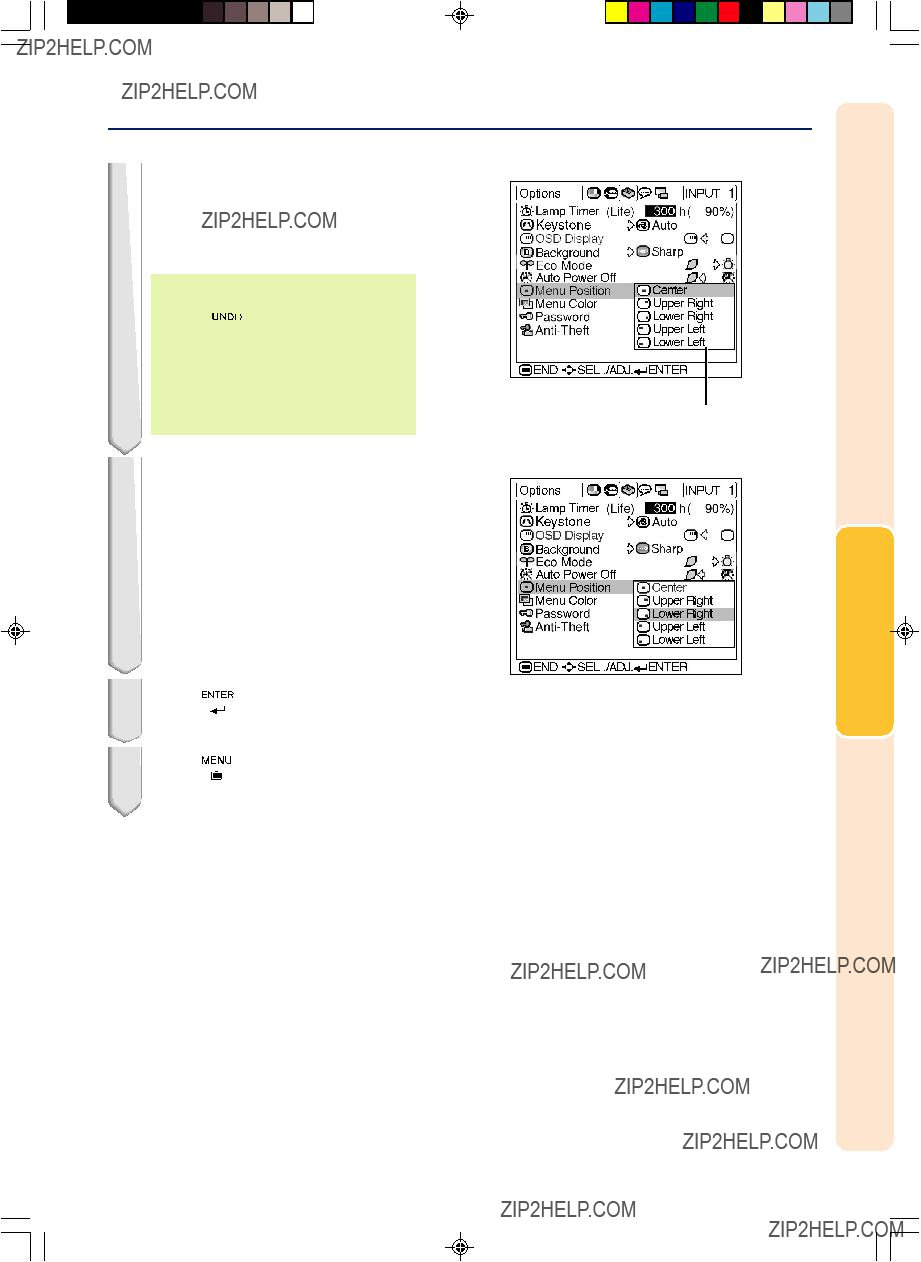
3 Press ' or " to select the item you want to set, and then press |to display the sub menu.
???The selected item is highlighted.
 Note
Note
???Press  or \ to return to the pre- vious screen.
or \ to return to the pre- vious screen.
???For some items, press \ or | to se- lect the icon using ??? ???.
???.
4 Press ' or " to select the set- ting of the item displayed in the sub menu.
5 Press  .
.
??? The item selected is set.
6 Press  .
.
??? The menu screen will disappear.
Sub menu
Operation Basic
 -35
-35

Picture Adjustment
You can adjust the projector???s picture to your preferences using the ???Picture??? menu. For operation of the menu screen, see pages 32 to 35.
Example: ???Picture??? screen menu for INPUT 1 (RGB) mode
Adjusting the Image
Select the item on the ???Picture??? menu and adjust the image.
Description of Adjustment Items
 CLR Temp (Adjusting the
CLR Temp (Adjusting the
Color Temperature)
Select ???CLR Temp??? on the ???Picture??? menu and the desired color temperature setting.
Description of Color Temperature Settings
 Note
Note
??????Color???, ???Tint??? and ???Sharp??? are not displayed when selecting INPUT 1 and setting the ???Sig- nal Type??? to ???RGB??? or setting the ???Signal Type??? to ???Auto??? and the input signal is recognized as an RGB signal.
??????Sharp??? can be adjusted when 480I, 480P, 540P, 580I, 580P, 720P, 1035I or 1080I signals are detected while ???Signal Type??? for INPUT 1 is set to ???Component??? or set to ???Auto??? and the input signal is recognized as a component signal.
???To reset all adjustment items, select ???Reset??? and press  .
.
 Note
Note
??? Values for ???CLR Temp??? are only approximations.
 -36
-36

 Gamma (Gamma Correction)
Gamma (Gamma Correction)
Gamma is an image quality enhancement function that offers a richer image by brightening the darker portions of the image without altering the bright- ness of the brighter portions.
When you are displaying images with frequent dark scenes, such as a film or concert, or when you are displaying images in a bright room, this feature makes the dark scenes easier to see and gives the impression of greater depth in the image.
Select ???Gamma??? on the ???Picture??? menu and the desired gamma mode.
Description of Gamma Modes
 Note
Note
???Gamma is not available for INPUT 1 when ???sRGB??? on the ???Picture??? menu is set to ???ON???.
 sRGB (sRGB Setting)
sRGB (sRGB Setting)
Select ???sRGB??? on the ???Picture??? menu and set it to ??? (ON)??? when you want to display the image in a natural tint based on an origi- nal image.
(ON)??? when you want to display the image in a natural tint based on an origi- nal image.
 Note
Note
???When ???sRGB??? is set to ???ON???;
???Gamma is not available.
??????Red???, ???Blue??? or ???CLR Temp??? on the ???Picture??? menu cannot be adjusted.
???For additional information about the sRGB func- tion, visit ???http://www.srgb.com/???.
 Info
Info
???When ???sRGB??? is set to ???ON???, the projected im- age may become dark, but this does not indi- cate a malfunction.
 Signal Type (Signal Type Setting)
Signal Type (Signal Type Setting)
The signal type setting is preset to ???Auto???; however, in rare cases a clear picture may not be displayed. In that case, select ???RGB??? or ???Component??? in accordance with the input signal.
Select ???Signal Type??? on the ???Picture??? menu and set it to ???Auto???, ???RGB??? or ???Component??? for INPUT 1.
Description of Signal Type Settings
 Memory (Storing and Selecting
Memory (Storing and Selecting
 Note
Note
???You can change the stored settings after se- lecting the memory location for those settings.
 -37
-37

Computer Image Adjustment
Using the ???Fine Sync??? menu, you can adjust the computer image, match the computer dis- play mode, and check the input signal. For operation of the menu screen, see pages 32 to 35.
Example: ???Fine Sync??? menu screen for
INPUT 1 mode
When ???Auto Sync??? is set to OFF or when vertical stripes or flickering occur in portions of the screen even if ???Auto Sync??? is set to ON, adjust ???Clock???, ???Phase???,
Ordinarily, the type of input signal is detected and the correct resolution mode is automatically selected. However, for some signals, the optimal resolution mode in ???Special Modes??? on the ???Fine Sync??? menu may need to be selected to match the computer dis- play mode.
Select the item on the ???Fine Sync??? menu and adjust the computer image.
Description of Adjustment Items
 Note
Note
???You can automatically adjust the computer im- age by setting ???Auto Sync??? on the ???Fine Sync??? menu or pressing the AUTO SYNC button. See next page for details.
???To reset all adjustment items, select ???Reset??? and press  .
.
Select ???Special Modes??? on the ???Fine Sync??? menu and the appropriate resolution.
 Note
Note
???Avoid displaying computer patterns which repeat every other line (horizontal stripes).
(Flickering may occur, making the image hard to see.)
???When a DVD player or Digital Video is connected, select 480P as the input signal.
???See ???Signal Info (Checking the Input Signal)??? on the next page for information on the currently se- lected input signal.
 -38
-38

 Auto Sync (Auto Sync Adjust- ment)
Auto Sync (Auto Sync Adjust- ment)
Used to automatically adjust a computer image.
Select ???Auto Sync??? on the ???Fine Sync??? menu and set it to ??? ???(ON) or ???
???(ON) or ??? ???(OFF).
???(OFF).
Description of Auto Sync Adjustment
 Signal Info (Checking the
Signal Info (Checking the
Input Signal)
Select ???Signal Info??? on the ???Fine Sync??? menu to check the current input signal informa- tion.
 Note
Note
ON
Auto Sync adjustment will occur when the projector is turned on or when the input signals are switched, when connected to a computer.
???The projector will display the number of scanned lines available from
OFF
Auto Sync adjustment is not automati-
cally perfomed.
 Note
Note
???Auto Sync adjustment is also performed by
pressing  on the projector or
on the projector or  on the remote control.
on the remote control.
???The Auto Sync adjustment may take some time to complete, depending on the image of the computer connected to the projector.
???When the optimum image cannot be achieved with Auto Sync adjustment, use manual adjust- ments. (See page 38.)
 AUTO SYNC button
AUTO SYNC button
AUTO SYNC button
Operation Basic
 -39
-39
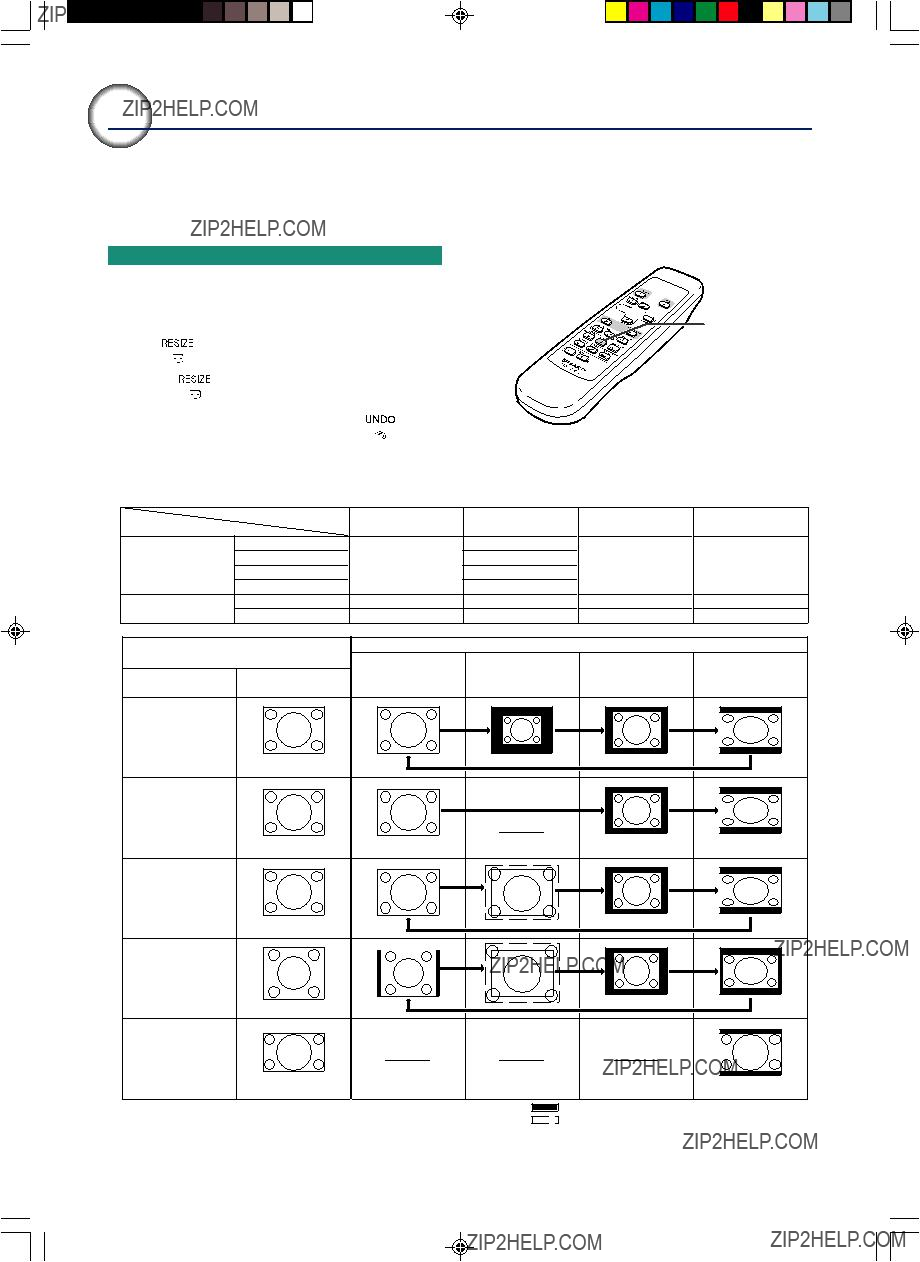
Picture Display Mode
This function allows you to modify or customize the picture display mode to enhance the input image. Depending on the input signal, you can choose ???NORMAL???, ???DOT BY DOT???, ???BORDER??? or ???STRETCH??? image.
Switching the Picture Dis- play Mode
Press  .
.
???Pressing  changes the display as shown on pages 40 and 41.
changes the display as shown on pages 40 and 41.
???To return to the standard image, press  while ???RESIZE??? is displayed on the screen.
while ???RESIZE??? is displayed on the screen.
UNDO
button 






RESIZE button
Input Signal
Resolution lower than
XGA
4:3 aspect ratio
XGA
4:3 aspect ratio
Resolution higher than
XGA
4:3 aspect ratio
SXGA (1280 ??? 1024)
5:4 aspect ratio
1280 ??? 720
16:9 aspect ratio
Output screen image
*
* Mode for projecting an image with the original aspect ratio without cutting any portions.
:Cutout area on which images cannot be projected.
:Area where the signals are off screen.
 -40
-40

VIDEO
??? ???STRETCH??? is fixed when 540P, 720P or 1080I signals are entered.
Input Signal
4:3 aspect ratio
Output screen image
480I, 480P,
Letter box
NTSC, PAL, SECAM
Squeezed 16:9 image
Squeezed 4:3 image
16:9 aspect ratio
540P, 720P, 1080I (16:9)
16:9 aspect ratio (4:3 aspect ratio in 16:9 screen)
*
*
*
*
to Easy
Use
* Mode for projecting an image with the original aspect ratio without cutting any portions.
: Cutout area on which images cannot be projected.
: Area on which the image is not included in the original signals.
Functions
 -41
-41

Still and Zoom Image
You can instantly freeze a moving image and enlarge a specific portion of an image with the remote control. Using these functions, you can explain the image to the audience more ef- fectively.
Freezing a Moving
Image
1 Press  .
.
??? The projected image is frozen.
2 Press  again to return to the
again to return to the
moving image from the currently connected device.
Displaying an Enlarged
Portion of an Image
1 Press  .
.
???Pressing  or
or  enlarges or reduces the projected image.
enlarges or reduces the projected image.
 Note
Note
???1 ???2 ???3 ???4 ???9 ???16 ???36 ???64
??? You can change the location of the en- larged image using ', ", \ and |.
2 Press  to cancel the operation.
to cancel the operation.
??? The magnification then returns to ???1.
 Note
Note
In the following cases, the image will re- turn to the normal size (???1).
??? When switching the INPUT mode.
??? When  has been pressed.
has been pressed.
??? When the input signal is changed.
??? When the input signal resolution and re- fresh rate (vertical frequency) change.
 -42
-42
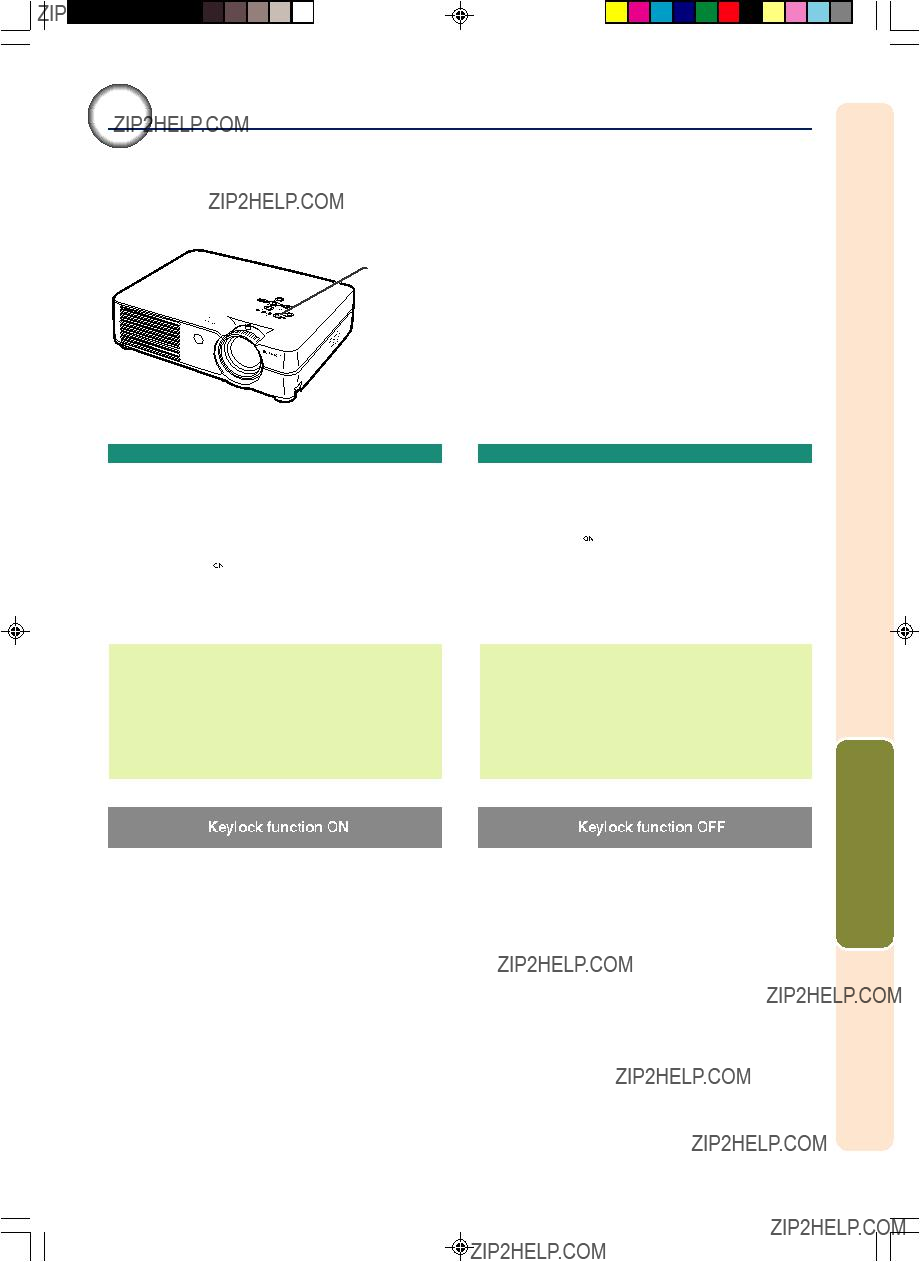
Keylock Function
Use this function to lock the operation buttons on the projector.
ON button
Locking the Operation But- tons
Hold down  on the projector for about 3 seconds while the projector is being turned on.
on the projector for about 3 seconds while the projector is being turned on.
 Note
Note
???The keylock function does not affect the opera- tion with the remote control buttons.
???You cannot use the keylock function while the projector is warming up or shutting down.
Taking the Keylock off
Hold down  on the projector for about 3 seconds.
on the projector for about 3 seconds.
 Note
Note
??? The keylock function does not affect the opera- tion with the remote control buttons.
??? You cannot use the keylock function while the projector is warming up or shutting down.Easy
Use to Functions
 -43
-43

Using the ???Options??? Menu
You can use the ???Options??? menu to enhance the usage for the projector. For operation of the menu screen, see pages 32 to 35.
Example: ???Options??? menu screen for INPUT 2
 Lamp Timer (Life) (Check-
Lamp Timer (Life) (Check-
ing the Lamp Life Status)
You can confirm the cumulative lamp usage time and the remaining lamp life (percentage).
Display the ???Options??? menu to check the lamp life status.
Description of Lamp Life
 Note
Note
???It is recommended that the lamp be changed when the remaining lamp life becomes 5%. For lamp replacement, contact your nearest Sharp Authorized Projector Dealer or Service Center.
???The table above indicates rough estimates in the case of using only in each mode shown. Remain- ing lamp life changes within the range of the val-
ues shown depending on the frequency at which
???Eco Mode??? is switched to ??? ??? (Eco mode) and ???
??? (Eco mode) and ??? ??? (Standard mode) (see page 45).
??? (Standard mode) (see page 45).
 Keystone (Setting the Key- stone Correction Mode)
Keystone (Setting the Key- stone Correction Mode)
Select ???Keystone??? on the ???Options??? menu and the desired mode for the Keystone Correction.
 Auto
Auto
 Manual
Manual
Description of Keystone Correction Mode
 Note
Note
???If you want to adjust the Keystone Correction manually, see page 29.
???The Keystone Correction can be adjusted up to an angle of approximately ??12?? when the Key- stone Correction mode is set to ???Auto???, or ap- proximately ??35?? when set to ???manual??? (when the picture display mode is set to ???NORMAL??? (see page 40)).
 -44
-44

 OSD Display (Setting On- screen Display)
OSD Display (Setting On- screen Display)
This function allows you to turn the
Select ??? ??? (ON) or ???
??? (ON) or ??? ??? (OFF) in ???OSD Display??? on the ???Options??? menu.
??? (OFF) in ???OSD Display??? on the ???Options??? menu.
Description of ???OSD Display??? Settings
*Displayed when the STANDBY button is pressed.
 Video System (Setting the
Video System (Setting the
Video System)
The video input system mode is preset to ???Auto???; however, a clear picture from the connected audio- visual equipment may not be received, depending on the video signal difference. In that case, switch the video signal.
Select ???Video System??? on the ???Options??? menu and the appropriate video system.
Description of Video Systems
 Note
Note
???The video signal can only be set in INPUT 2 or INPUT 3 mode.
???In ???Auto???, images are displayed in PAL even if
 Background (Selecting a
Background (Selecting a
Startup and Background Image)
Select ???Background??? on the ???Options??? menu and the image displayed upon the projector???s startup and when no signal is being sent to the projector.
 Sharp
Sharp
 Blue
Blue
 None
None
Description of Background Images
 Note
Note
???If the input signal has interference, the screen will be displayed during interference.
 Eco Mode (Setting the Eco
Eco Mode (Setting the Eco
Mode)
 Note
Note
???Although lamp life and noise are improved when
???Eco Mode??? is set to ??? ??? (Eco mode), bright-
??? (Eco mode), bright-
ness decreases by 20%.
??? ???Eco Mode??? mode is factory preset to ??? ??? (Stan- dard mode).
??? (Stan- dard mode).
 -45
-45
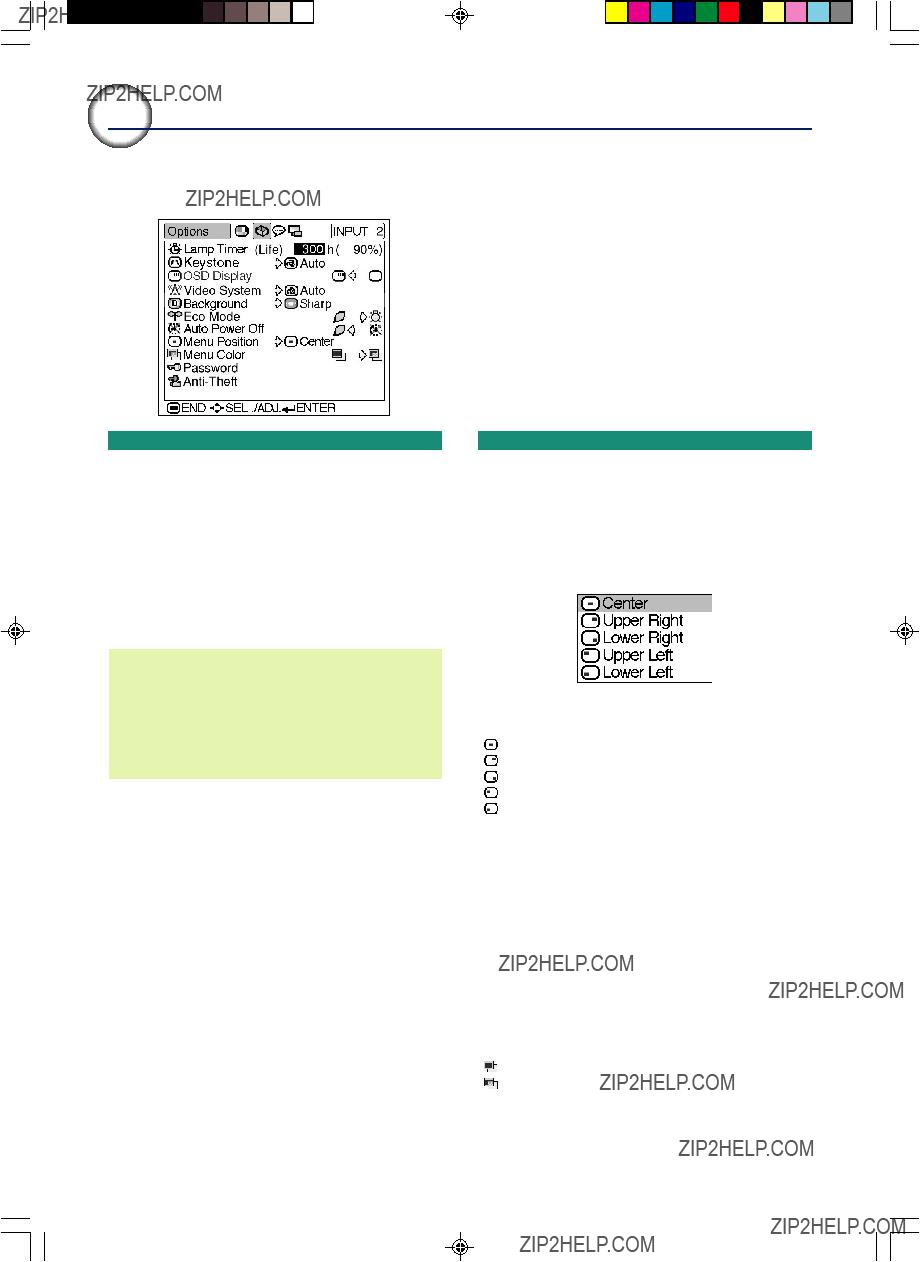
Using the ???Options??? Menu
Example: ???Options??? menu screen for INPUT 2
 Auto Power Off (Auto
Auto Power Off (Auto
Power Off Function)
When no input signal is detected for more than 15 minutes, the projector will automatically enter the standby mode if set to ???ON???.
The Auto Power Off function will be disabled if it has been set to ???OFF???.
Select ??? ??? (ON) or ???
??? (ON) or ??? ??? (OFF) in ???Auto Power Off??? on the ???Options??? menu.
??? (OFF) in ???Auto Power Off??? on the ???Options??? menu.
 Note
Note
???When the Auto Power Off function is set to ???ON???, 5 minutes before the projector enters the standby mode, the message ???Enter STANDBY mode in X min.??? will appear on the screen to indicate the remaining minutes before power off.
 Menu Position (Selecting
Menu Position (Selecting
the Menu Screen Position)
Select ???Menu Position??? on the ???Options??? menu and the desired position for the menu screen.
Description of Menu Positions
 Menu Color (Selecting the
Menu Color (Selecting the
Menu Color)
Select ??? ??? (Opaque) or ???
??? (Opaque) or ??? ??? (Translucent) in ???Menu Color??? on the ???Options??? menu.
??? (Translucent) in ???Menu Color??? on the ???Options??? menu.
Description of Menu Colors
 -46
-46
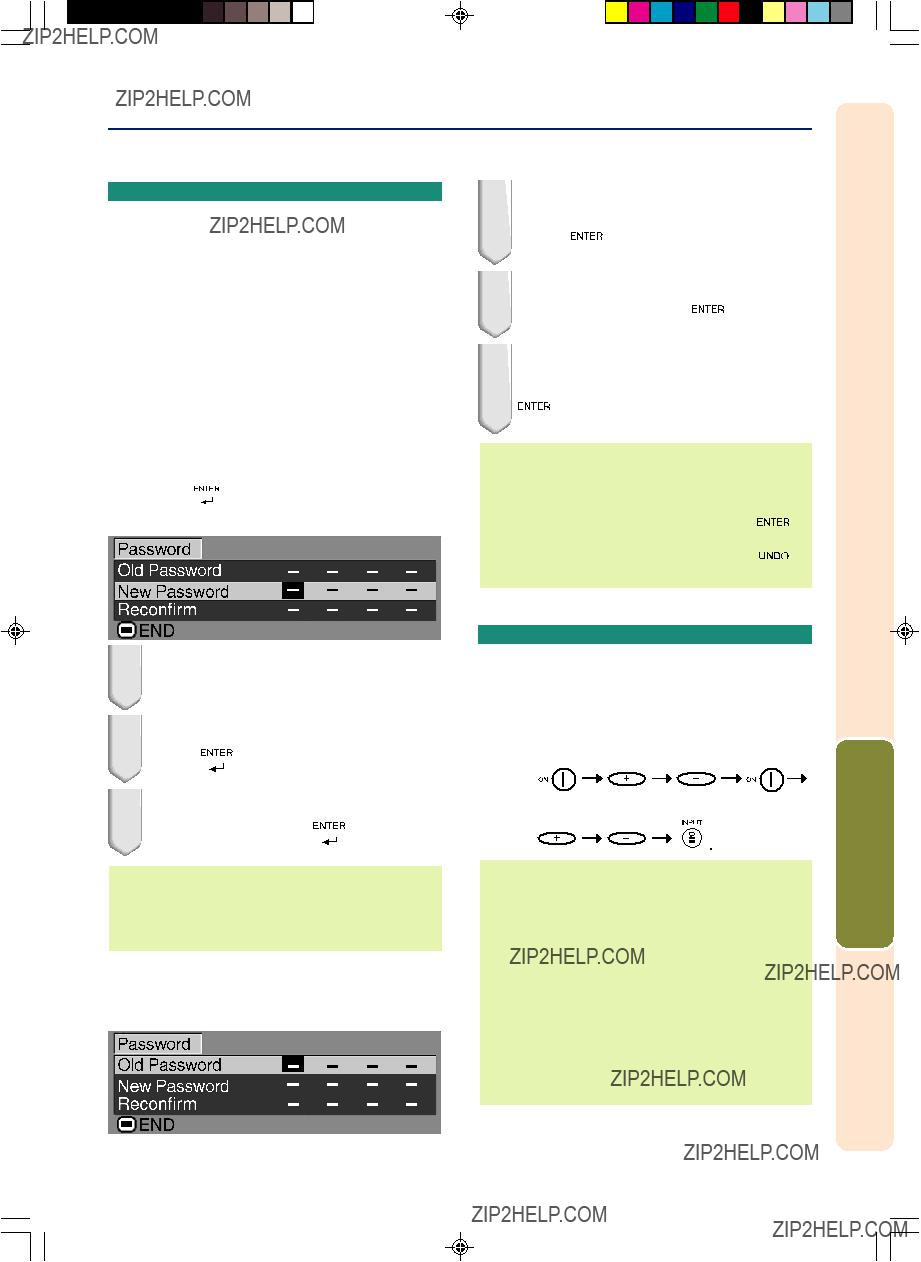
 Password (Setting a Pass- word)
Password (Setting a Pass- word)
A password must be set to activate the
There is no factory preset for the password or the
A password can only be set by using the remote control.
Select ???Password??? on the ???Options??? menu, then press  and follow the procedure be- low to enter the password.
and follow the procedure be- low to enter the password.
1 Press ', " and | to enter the password in ???Old Password??? and press  .
.
2 Press ', " and | to set the new password and press  .
.
3 Enter the new
 .
.
 Note
Note
???If you do not want to set a password, leave the fields in steps 2 and 3 blank and press  .
.
???To cancel the password settings, press  .
.
1 Press ' or " to select the desired number and then press |.
2 Enter the 3 remaining digits and press  .
.
3 Enter the password again in ???Re- confirm??? and press  .
.
 Note
Note
???When a password is set, you need to enter the password to change the
If you want to change the password, follow the procedure below.
If You Forget Your Pass- word
If you forget the password, delete it using the fol- lowing procedure and set a new password.
Press
 Note
Note
???You can only use the buttons on the projector to delete the password.
???The password cannot be deleted using the above described procedures while the ???Anti- Theft??? function is set. If you forget your pass- word while the
 -47
-47
to Easy
Functions Use

Using the ???Options??? Menu
Example: ???Options??? menu screen for INPUT 2

The
Select  and follow the procedure be- low to enter the keycode.
and follow the procedure be- low to enter the keycode.
 Note
Note
???
???When
 Info
Info
???Once the function is activated, you must remem- ber the correct keycode. We suggest you record the keycode in a safe place where only authorized users have access. If you lose or forget your keycode, you will need to contact your nearest Sharp Authorized Projector Dealer or Service Cen- ter (see page 65). You may need to bring your projector to them to restore the projector to original factory condition (password and keycode reset).
 -48
-48
1 Press any button you like on the re- mote control or projector to set the first digit in ???New Code???.
 Note
Note
???The following buttons on the remote con- trol and projector cannot be set as keycodes:
???ON button
???STANDBY button
???ENTER button
???UNDO button
???MENU button
???FORWARD button
???BACK button
2 Enter the remaining 3 digits by pressing any buttons you like.
3 Enter the same keycode once more in ???Reconfirm???.
 Info
Info
When
???Press the buttons on the remote control if the buttons on the remote control are used for set- ting the keycode. In the same manner, press the buttons on the projector if the buttons on the projector are used for setting the keycode.

If you want to change the keycode, follow the procedure below.
 Note
Note
???When
1 Press the buttons on the remote control or the projector to enter the preset
2 Press any button you like on the re- mote control or the projector to en- ter the new keycode.
3 Enter the same
 Note
Note
???If you do not want to set a keycode, leave the keycode field blank in steps 2 and 3 and press  .
.
to Easy
Functions Use
 -49
-49

Reversing/Inverting Projected Images
You can reverse or invert the projected image for various applications using the ???PRJ Mode??? menu. For operation of the menu screen, see pages 32 to 35.
Example: ???PRJ Mode??? menu screen for
INPUT 1 (RGB) mode
Setting the Projection
Mode
Display the ???PRJ Mode??? menu and select the desired projection mode.
Description of Projection Modes
 Note
Note
???This function is used for the reversed image and
 -50
-50

Carrying the Projector
How to Use the
Carrying Case
When carrying the projector, attach the lens cap to the lens, and place it in the supplied carrying case.
1 Open the cover of the carrying case.
2 Remove the inner padding from the carrying case, and fold it in the direction of the arrows.
3 Reinsert the inner padding into the carrying case.
 Info
Info
???Be sure to insert the inner padding to protect the lens and the projector.
4 Place the projector and the ac- cessories in the carrying case.
 Info
Info
???Be sure to attach the lens cap to pro- tect the lens.
???Be sure the projector has cooled down sufficiently before placing it in the case.
 Info
Info
???This carrying case is only for storing and carrying the projector.
???Sending the projector in the carrying case as a parcel may cause damage to the pro- jector. If you send the projector in the car- rying case as a parcel, be sure to place it in a sturdy case and with enough shock absorbing material to avoid any damage.
???Do not expose the carrying case or projec- tor to direct sunlight, near heat sources, or leave them in a car. The carrying case or projector may change color or become de- formed.
Lens cap
Adjust the shoulder strap.
Appendix
 -51
-51

Maintenance
Cleaning the projector
???Be sure to unplug the power cord before cleaning the projector.
???The cabinet as well as the operation panel is made of plastic. Avoid using benzene or thinner, as these can damage the finish on the cabinet.
???Do not use volatile agents such as insecticides on
the projector.
Do not attach rubber or plastic items to the projector for a long time.
The effects of some of the agents in the plastic may cause damage to the quality or finish of the projector.
Cleaning the lens
???Use a commercially available blower or lens cleaning paper (for glasses and camera lenses) for cleaning the lens. Do not use any liquid type cleaning agents, as they may wear off the coating film on the surface of the lens.
???As the surface of the lens can easily get damaged, be sure not to scrape or hit the lens.
Cleaning
Paper
Wax
Thinner
Cleaning the exhaust and intake vents
??? Use a vacuum cleaner to clean dust from the exhaust vent and the intake vent.
??? Wipe off dirt gently with a soft flannel cloth.
M
ild
d
e
te
rg
e
n t
Mild detergent diluted with water
???When the dirt is hard to remove, soak a cloth in a mild detergent diluted with water, wring the cloth well and then wipe the projector.
Strong cleaning detergents may discolor, warp or damage the coating on the projector.
Make sure to test on a small, inconspicuous area on the projector before use.
 -52
-52
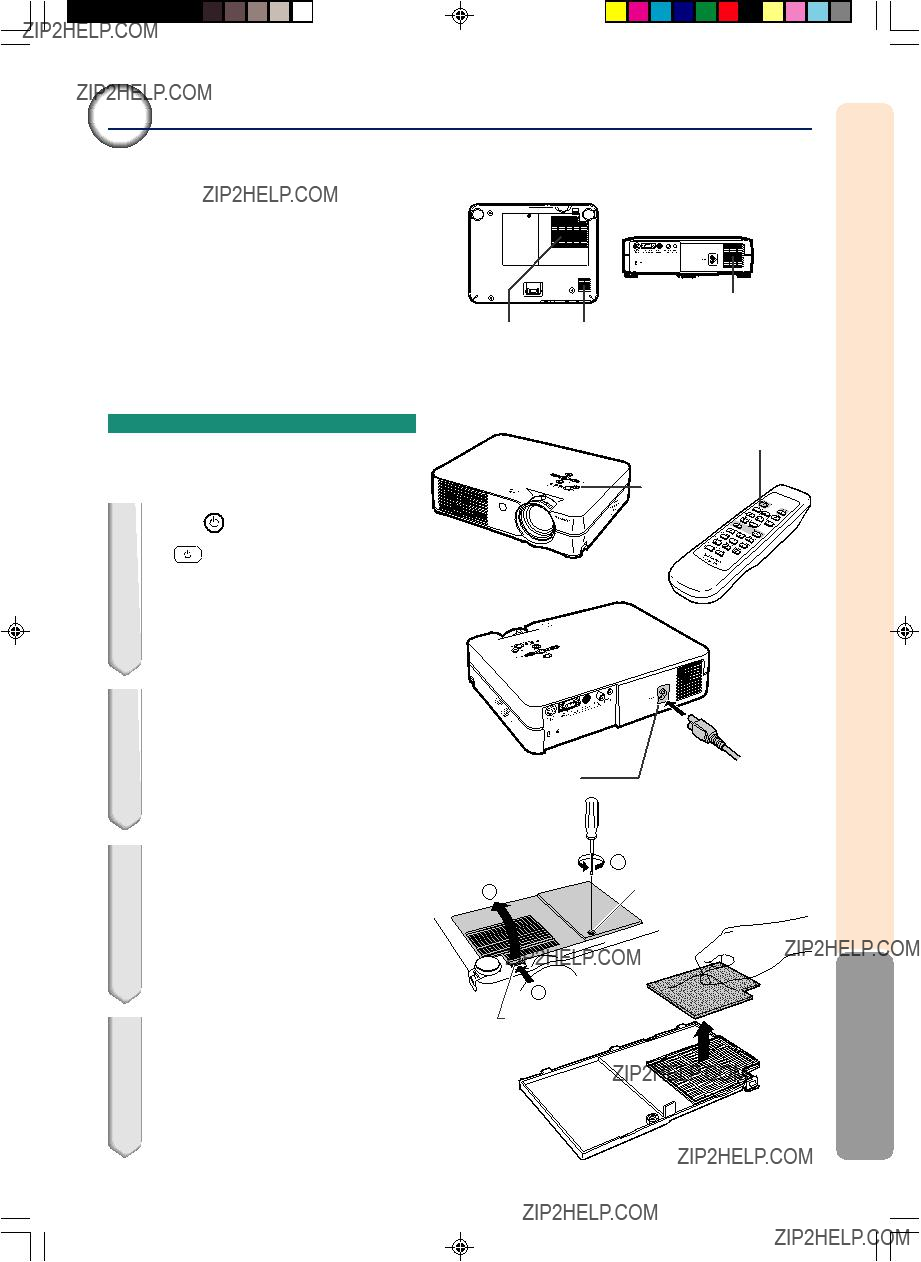
Replacing the Air Filter
???This projector is equipped with air fil- ters to ensure the optimal operating condition of the projector.
???The air filters should be cleaned every 100 hours of use. Clean the filters more often when the projector is used in a dusty or smoky location.
???Ask your nearest Sharp Authorized Pro- jector Dealer or Service Center to ex- change the filter (PFILDA008WJZZ) when it is no longer possible to clean.
Cleaning and Replacing
the Air Filter
1 Press STANDBY on the projector or STANDBY on the remote control to
put the projector into the standby mode.
??? Wait until the cooling fan stops.
2 Disconnect the power cord.
???Unplug the power cord from the AC socket.
3 Remove the filter/lamp unit cover.
???Turn the projector over. Loosen the user service screw (1) that secures the fil-
ter/lamp unit cover. Pressing the tab (2), remove the filter/lamp unit cover (3).
4 Remove the air filter.
???Pick the air filter up with your fingers and lift it out of the filter/lamp unit cover.
" Bottom view
" Rear view
STANDBY button
AC socket
1
2
 -53
-53
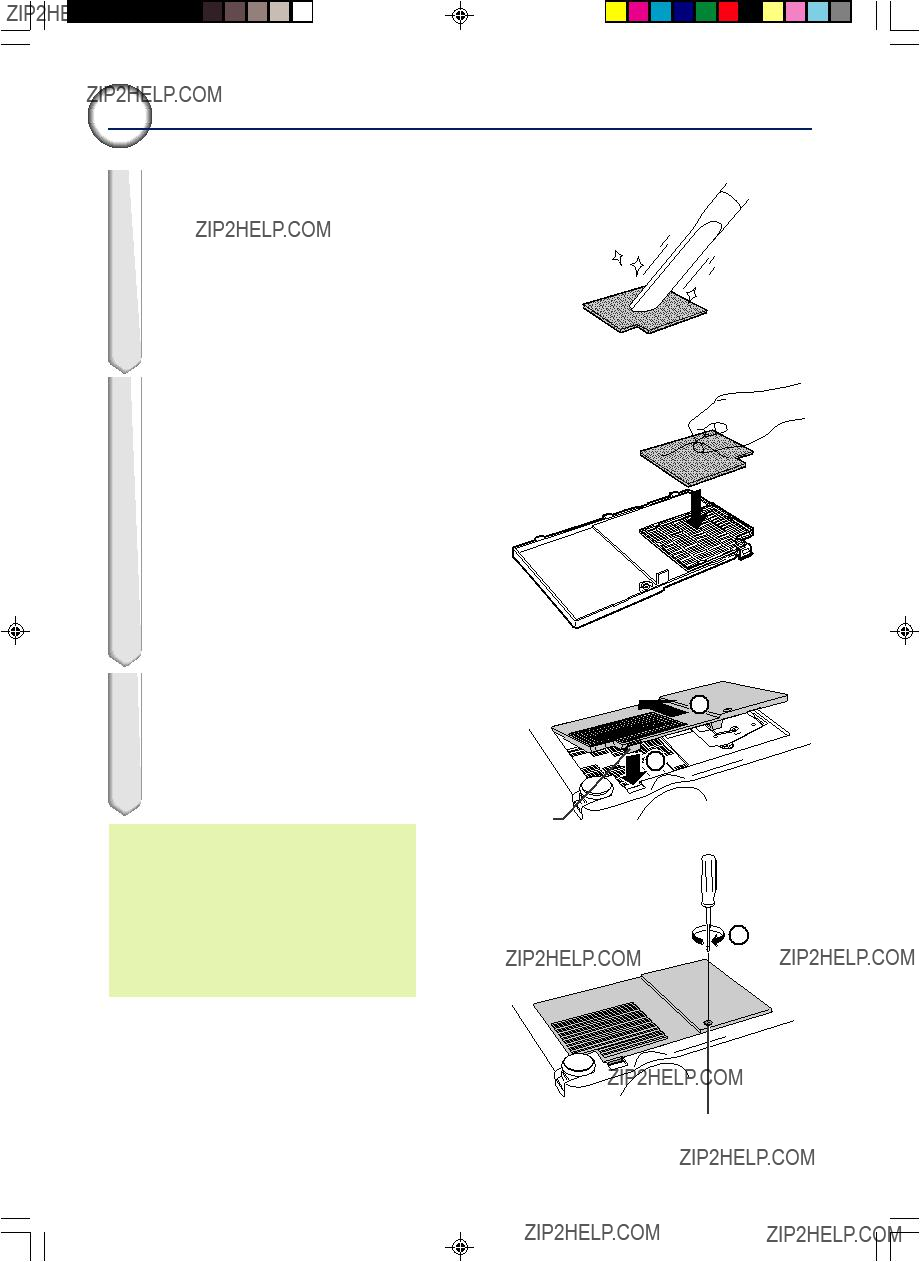
Replacing the Air Filter
5 Clean the air filter.
???Clean the dust off the air filter and cover with a vacuum cleaner extension hose.
6 Replace the air filter.
???Place the air filter underneath the tabs on the filter/lamp unit cover.
7 Replace the filter/lamp unit cover.
???Align the tab on the filter/lamp unit cover (1) and place it while pressing the tab (2) to close it. Then tighten the user service screw (3) to secure the filter/ lamp unit cover.
 Note
Note
???Be sure the filter/lamp unit cover is securely installed. The power will not turn on unless it is correctly installed.
???If dust or dirt has collected inside the rear and bottom air filters (not removable), clean the filter with a vacuum cleaner extension hose.
 -54
-54
 1
1





 2
2 
Tab
3
User service screw

Maintenance Indicators
???The warning lights on the projector indicate problems inside the projector.
???If a problem occurs, either the temperature warning indicator or the lamp indicator will illuminate red, and the projector will enter the standby mode. After the projector has entered the standby mode, follow the procedures given below.
About the temperature warning indicator
If the temperature inside the pro- jector increases, due to blockage of the air vents, or the setting lo-
cation, ??? ??? will illuminate in
??? will illuminate in
the lower left corner of the picture. If the temperature keeps on rising, the lamp will turn off and the tem- perature warning indicator will blink, the cooling fan will run for a further 90 seconds, and then the projector will enter the standby mode. After
??? ??? appears, be sure to per- form the following measures.
??? appears, be sure to per- form the following measures.
???The lamp life becomes 0%, when used for approximately 4,500 hours with ???Eco Mode??? or when used for approximately 3,000 hours with ???Standard Mode??? (see page 45).
???When the remaining lamp life becomes
5% or less, ??? ??? (yellow) will be displayed on the screen. When the percentage be-
??? (yellow) will be displayed on the screen. When the percentage be-
comes 0%, ??? ??? will change to ???
??? will change to ??? ??? (red), the lamp will automatically turn off and then the projector will automatically en- ter the standby mode. At this time, the lamp indicator will illuminate in red.
??? (red), the lamp will automatically turn off and then the projector will automatically en- ter the standby mode. At this time, the lamp indicator will illuminate in red.
???If you try to turn on the projector a fourth time without replacing the lamp, the pro- jector will not turn on.
Appendix
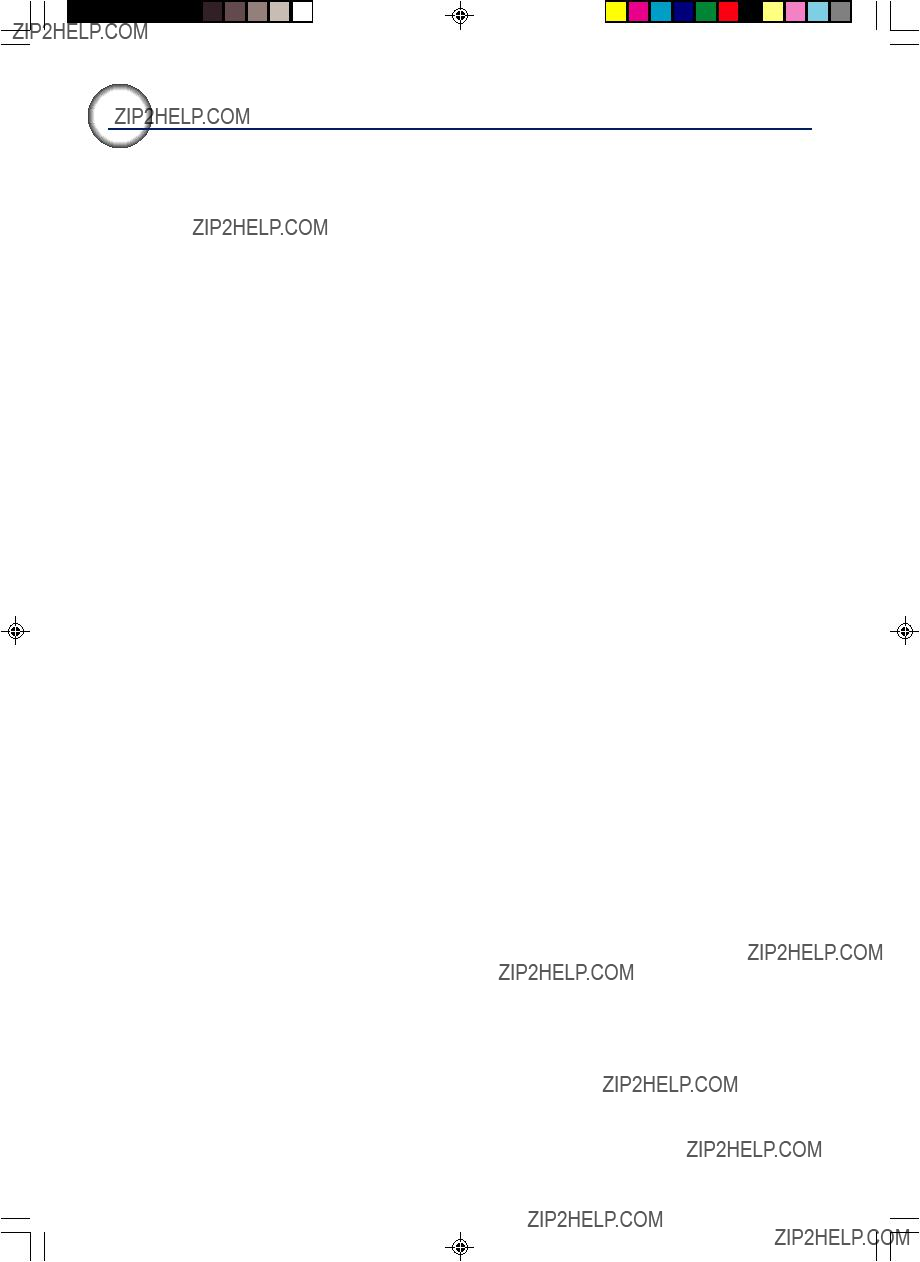
Maintenance Indicators
 Info
Info
???If the temperature warning indicator illuminates, and the projector enters the standby mode, follow the pos- sible solutions on the previous page and then wait until the projector has cooled down completely before plugging in the power cord and turning the power back on. (At least 5 minutes.)
???If the power is turned off for a brief moment due to power outage or some other cause while using the projector, and the power supply recovers immediately after that, the lamp indicator will illuminate in red and the lamp may not be lit. In this case, unplug the power cord from the AC outlet, replace the power cord in the AC outlet and then turn the power on again.
???If you want to clean the air vents during projector operation, be sure to put the projector into the standby mode. After the cooling fan has stopped, clean the vents.
???Do not unplug the power cord after the projector has entered the standby mode and while the cooling fan is running. The cooling fan runs for about 90 seconds.
 -56
-56

Regarding the Lamp
Lamp
???It is recommended that the lamp (sold separately) be replaced when the remaining lamp life be- comes 5% or less, or when you notice a significant deterioration in the picture and color quality. The lamp life (percentage) can be checked with the
???For lamp replacement, please consult your nearest Sharp Authorized Projector Dealer or Service Center.
IMPORTANT NOTE TO U.S. CUSTOMERS:
The lamp included with this projector is backed by a
of this projector under warranty, including lamp replacement, must be obtained through a Sharp Autho- rized Projector Dealer or Service Center. For the name of the nearest Sharp Authorized Projector Dealer or Service Center, please call 

Caution Concerning the Lamp
???This projector utilizes a pressurized mercury lamp. A loud sound may indicate lamp failure. Lamp failure can be attributed to numerous sources such as: excessive shock, improper cooling, surface scratches or deterioration of the lamp due to a lapse of usage time. The period of time up to failure largely varies depending on the individual lamp and/or the condition and the frequency of use. It is important to note that failure can often result in the bulb cracking.
???When the lamp replacement indicator and
???Should the lamp break, the glass particles may spread inside the lamp cage or gas contained in the lamp may be vented into the room from the exhaust vent. Because the gas in this lamp includes mercury, ventilate the room well if the lamp breaks and avoid all exposure to the released gas. In case of exposure to the gas, consult a doctor as soon as possible.
???Should the lamp break, there is also a possibility that glass particles may spread inside of the projector. In such a case, it is recommended you contact your nearest Sharp Authorized Projector Dealer or Service Center to remove the damaged lamp and assure safe operation.
Replacing the Lamp
 Caution
Caution
???Do not remove the lamp unit immediately after operation of the projector. The lamp will be hot and touching it can lead to burn or injury.
???Wait at least one hour after the power cord is disconnected to allow the surface of the lamp unit to fully cool before removing the lamp unit.
???If the new lamp does not light after replacement, take your projector to the nearest Sharp Autho- rized Projector Dealer or Service Center for repair. Purchase a replacement lamp unit of type BQC- PGA20X//1 from your nearest Sharp Authorized Projector Dealer or Service Center. Then carefully change the lamp by following the instructions described in this section. If you wish, you may have the lamp replaced at your nearest Sharp Authorized Projector Dealer or Service Center.
Appendix
 -57
-57

Regarding the Lamp
Removing and Installing
the Lamp Unit
 Info
Info
???Be sure to remove the lamp unit using the handle. Be sure not to touch the glass sur- face of the lamp unit or the inside of the projector.
???To avoid injury to yourself and damage to the lamp, be sure to carefully follow the steps below.
???Do not loosen other screws except for the filter/lamp unit cover and lamp unit.
???Please refer to the installation manual in- cluded with the lamp unit.
1 Press  STANDBY on the projector or STANDBY on the remote control to
STANDBY on the projector or STANDBY on the remote control to
put the projector into the standby mode.
??? Wait until the cooling fan stops.
 Warning!
Warning!
???Do not remove the lamp unit from the projector right after use. The lamp will be very hot and may cause burn or in- jury.
2 Disconnect the power cord.
???Unplug the power cord from the AC socket.
???Leave the lamp until it has fully cooled down (about 1 hour).
3 Change the air filter.
???Change the air filter whenever you in- stall the lamp unit (see pages 53 and
54).
4 Remove the filter/lamp unit cover.
???Turn the projector over. Loosen the user service screw (1) that secures the fil-
ter/lamp unit cover. Pressing the tab (2), remove the filter/lamp unit cover (3).
 -58
-58
Lamp





 STANDBY
STANDBY 





 button
button
STANDBY button
AC socket
1
3
 User
User
service
screw
2 Tab

5 Remove the lamp unit.
???Loosen the securing screws from the lamp unit. Hold the lamp unit by the handle and pull it in the direction of the arrow. At this time, keep the lamp unit horizontal and do not tilt it.
6 Insert the new lamp unit.
???Press the lamp unit firmly into the lamp unit compartment. Fasten the securing screws.
7 Replace the filter/lamp unit cover.
???Align the tab on the filter/lamp unit cover (1) and place it while pressing the tab (2) to close it. Then tighten the user service screw (3) to secure the filter/ lamp unit cover.
 Info
Info
???If the lamp unit and filter/lamp unit cover are not correctly installed, the power will not turn on, even if the power cord is con- nected to the projector.
Resetting the Lamp Timer
Reset the lamp timer after replacing the lamp.
1 Connect the power cord.
???Plug the power cord into the AC socket of the projector.
2 Reset the lamp timer.
??? While simultaneously holding down
 and
and  on the projector, press and
on the projector, press and  on the projector.
on the projector.
??????LAMP 0000H??? is displayed, indicating that the lamp timer is reset.
 Info
Info
???Make sure to reset the lamp timer only when replacing the lamp. If you reset the lamp timer and continue to use the same lamp, this may cause the lamp to become damaged or explode.
Handle
Securing screws
3
 1
1




 2
2
User service screw
AC socket
ON button
 -59
-59

Connecting Pin Assignments
INPUT 1 RGB Signal Terminal:
 Note
Note
??? Pin 8 (CS) and Pin 7 (RS) are short circuited inside the projector.
 Note
Note
??? Depending on the controlling device used, it may be necessary to connect Pin 4 and Pin 6 on the controlling
device (e.g. PC).
PC
Pin No.
4
5
6
 -60
-60
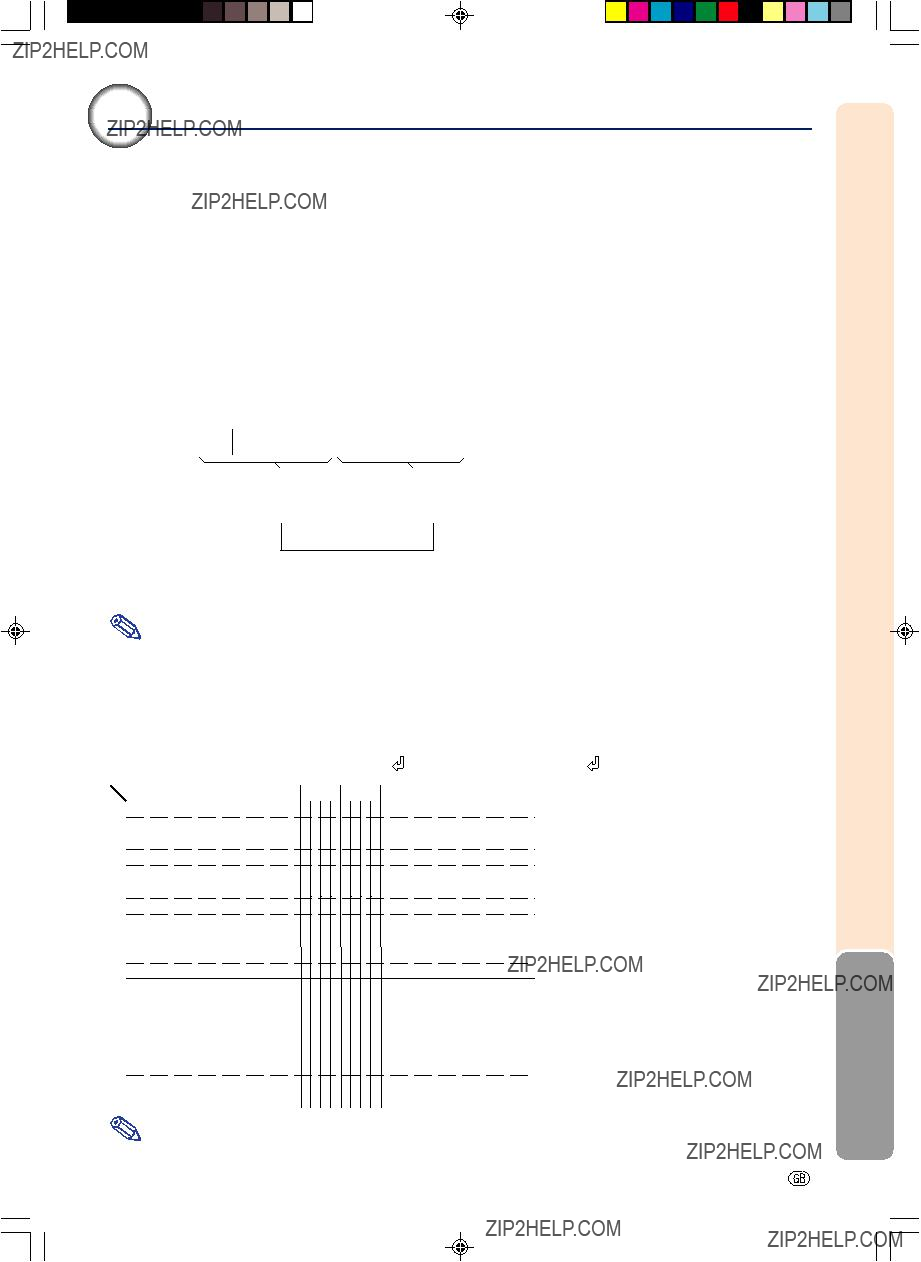
PC control
A computer can be used to control the projector by connecting an
Communication conditions
Set the serial port settings of the computer to match that of the table.
Basic format
Commands from the computer are sent in the following order: command, parameter, and return code. After the projector processes the command from the computer, it sends a response code to the computer.
Command format
 Info
Info
???When more than one code is being sent, send each command only after the response code for the previous command from the projector is verified.
Note
???When the projector is put into the standby mode, a message ???Shutting Down. Please Wait.??? is displayed for about 20 seconds. At that time, if the ???POWR_ _ _1??? command is being sent, ???ERR??? will be returned and this command is not received.
Commands
Example: When turning on the projector, make the following setting.
Note
???If an underbar (_) appears in the parameter column, enter a space. If an asterisk (*) appears, enter a value in the range indicated in brackets under CONTROL CONTENTS.
Appendix

Computer Compatibility Chart
Computer
???Multiple signal support
Horizontal Frequency:
???Compatible with sync on green signal
???SXGA+ and SXGA compatible in intelligent compression
???Intelligent Compression and Expansion System resizing technology
The following is a list of modes that conform to VESA. However, this projector supports other signals that are not VESA standards.
 Note
Note
???This projector may not be able to display images from notebook computers in simultaneous (CRT/LCD) mode. Should this occur, turn off the LCD display on the notebook computer and output the display data in ???CRT only??? mode. Details on how to change display modes can be found in your notebook computer???s operation manual.
???When this projector receives 640 ??? 350 VESA format VGA signals, ???640 ??? 400??? appears on the screen.
DTV
 -62
-62

Troubleshooting
Appendix

Troubleshooting
 -64
-64

For SHARP Assistance
If you encounter any problems during setup or operation of this projector, first refer to the ???Troubleshooting??? section on pages 63 and 64. If this operation manual does not answer your question, please contact the SHARP Service departments listed below.
Appendix

Specifications
As a part of policy of continuous improvement, SHARP reserves the right to make design and specification changes for product improvement without prior notice. The performance specification figures indicated are nominal values of production units. There may be some deviations from these values in individual units.
 -66
-66

Dimensions
Top View
9 1/32 (229)
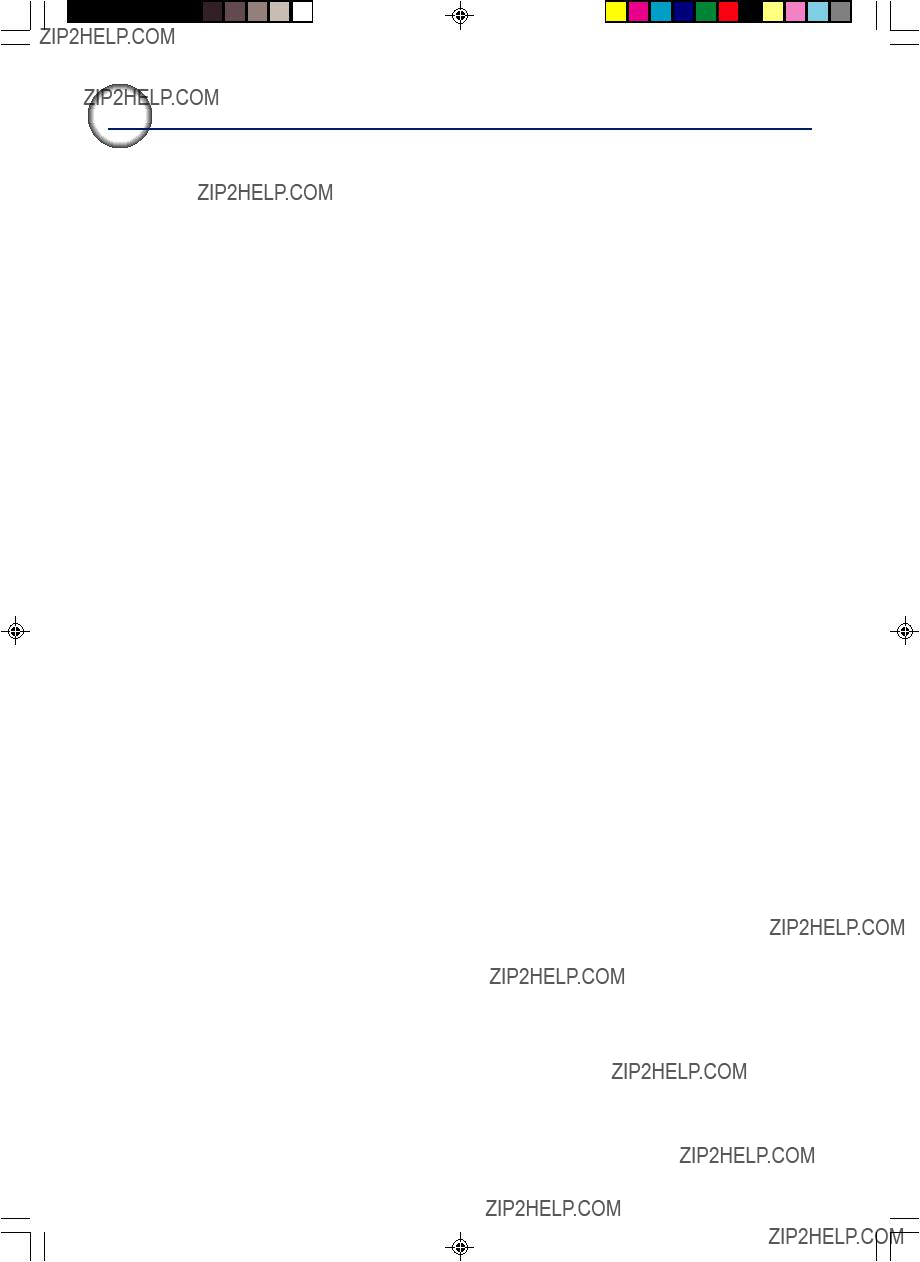
Glossary
If the ???Keycode??? set in the projector is not correctly entered, the projector will not operate even if sig- nals are entered.
Aspect Ratio
Width and height ratio of an image. The normal aspect ratio of a computer and video image is 4:3. There are also wide images with an aspect ratio of 16:9 and 21:9.
Auto Sync
Optimizes projected computer images by auto- matically adjusting certain characteristics.
Background
Initial setting image projected when no signal is being output.
Border
Projects a 4:3 image fully within a 16:9 screen by keeping the aspect ratio at 4:3.
Clock
Clock adjustment is used to adjust vertical noise when clock level is incorrect.
CLR Temp (Color temperature)
Function that can be used to adjust the color tem- perature to suit the type of image input to the pro- jector. Decrease the color temperature to create warmer, reddish images for natural flesh tones, or increase to create cooler, bluish images for a brighter picture.
Dot by dot
Mode that projects images in their native resolution.
Gamma
Image quality enhancement function that offers a richer image by brightening the darker portions of the image without altering the brightness of the brighter portions. You can select four different modes: STANDARD, PRESENTATION, CINEMA and GAME.
Intelligent compression
High quality resizing of lower and higher resolu- tion images to fit the projector???s native resolution.
Keylock
Mode that can lock the operation of projector but- tons to prevent unauthorized adjustment.
Keystone correction
Function to digitally correct a distorted image when the projector is set up at an angle, smooth- ens out jaggies on keystone images and com- presses the image not only horizontally but verti- cally keeping the 4:3 aspect ratio.
Password
A password is set so that changes cannot be made in the
 -68
-68
Phase
Phase shift is a timing shift between isomorphic signals with the same resolution. When phase level is incorrect, the projected image typically displays horizontal flicker.
Resize
Allows you to modify or customize the picture dis- play mode to enhance the input image. You can select four different modes: NORMAL, DOT BY DOT, BORDER and STRETCH.
sRGB
An international standard of color reproduction regulated by the IEC (International Electrotechnical Commission). As the fixed color area has been decided by the IEC, the color changes according to LCD features, so that the images are displayed in a natural tint based on an original image, when ???sRGB??? is set to ???ON???.
Stretch
Mode that stretches the 4:3 image horizontally to display it fully on a 16:9 screen.
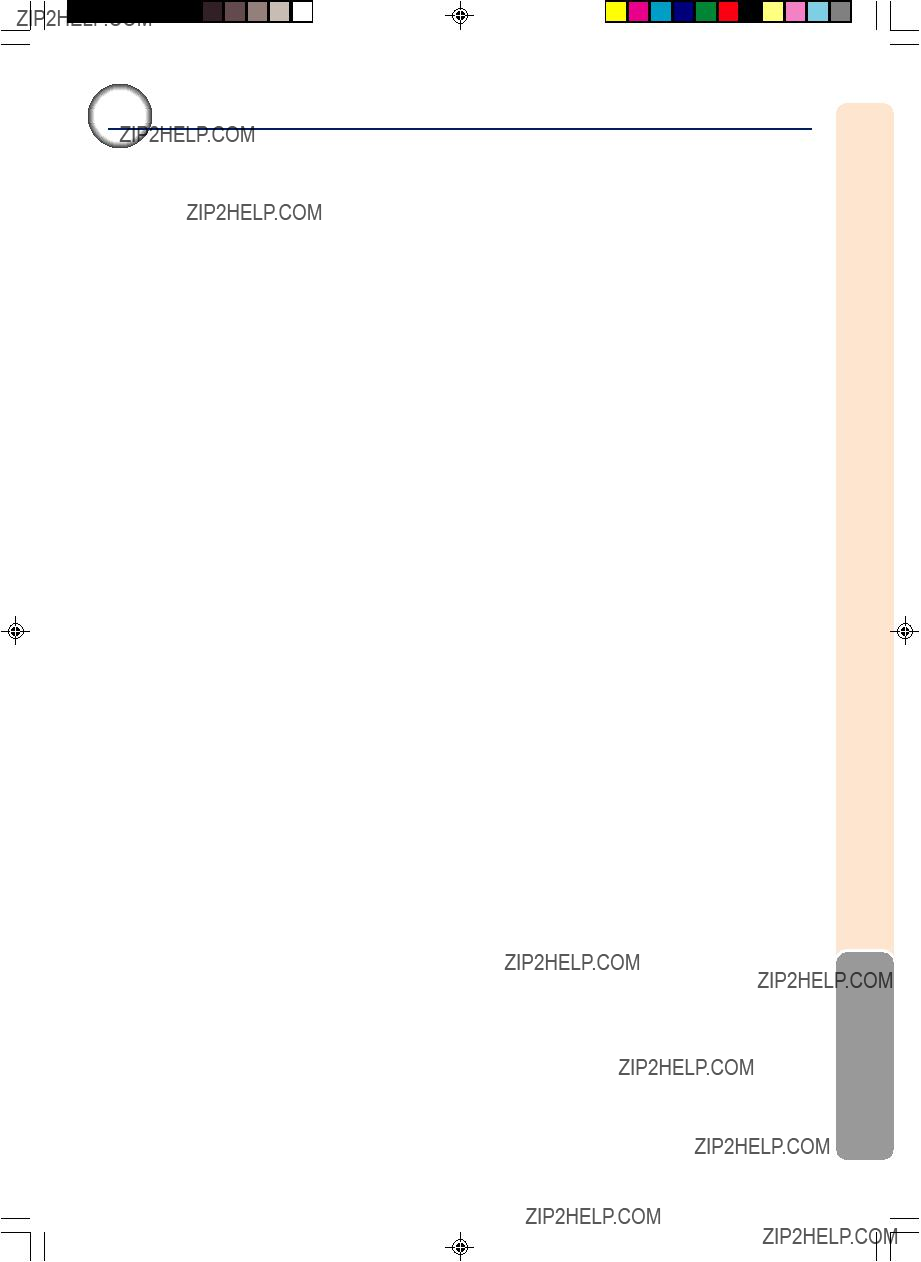
Index
Appendix
 -69
-69

SHARP CORPORATION